Shopping? Try:



 |

 |
Digital Photography News Archive!
January 2001
Back to current
news Back to Archive Index
Back to Archive Index
Tuesday, January 30, 2001
Casio QV-2300 Full Review posted!
By David Etchells, The Imaging Resource
(Tuesday, January 30, 2001 - 17:11 EST)
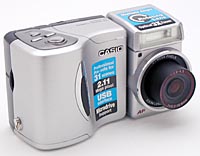 Casio was one of the earliest innovaters in the digicam markeplace, and have steadily made their way from a primary consumer-electronics focus to a more solidly photographic one. They've also taken the lead in the "value" category, by bundling the 340 MB IBM MicroDrive memory cards with their cameras. One of their recent models embodying both these trends is the QV-2300, a 2.1 megapixel with swivel zoom lens, good exposure controls and picture quality, a raft of preprogrammed "scene" modes, and an included MicroDrive. Overall a very nice package! Check it out! Casio was one of the earliest innovaters in the digicam markeplace, and have steadily made their way from a primary consumer-electronics focus to a more solidly photographic one. They've also taken the lead in the "value" category, by bundling the 340 MB IBM MicroDrive memory cards with their cameras. One of their recent models embodying both these trends is the QV-2300, a 2.1 megapixel with swivel zoom lens, good exposure controls and picture quality, a raft of preprogrammed "scene" modes, and an included MicroDrive. Overall a very nice package! Check it out!
Source: IR Review of Casio QV-2300!

UPDATED: Double Zounds!! $100MM to SiPix!
By David Etchells, The Imaging Resource
(Tuesday, January 30, 2001 - 12:25 EST)
This must be the week for mega-funding in digital imaging: We also just received word of the funding of SiPix Inc, a subsidiary of SiPix Group Limited that's being spun out as a new company. SiPix Group has been a major contract manufacturer of digital imaging gadgets of various sorts for some time now, but are now stepping out to produce products under their own brand. No word yet on what those products will be (stay tuned for more announcements soon), but check the numbers they're talking about for production capacity. (1 million digital cameras a month?! Where can that many digicams possibly go? Stay tuned for more info, an excerpt of the press release is below:
Milpitas, Calif. – Jan. 30, 2001– SiPix, Inc. a new company focused on delivering category killer digital imaging appliances to the consumer market, has officially opened its worldwide corporate headquarters. SiPix has received strategic funding exceeding $100 million led by Goldman Sachs, the global investment bank. Other key investors include Baring Private Equity Partners, CitiCorp Capital, Worldview Technology Partners and Telligent Investment Management LLC.
The first group of new products will be announced at the PMA International Convention and Trade Show in Orlando, Florida on February 11-14, 2001. SiPix will be demonstrating its innovative consumer products in booth #825.
With dedicated plants for digital imaging appliances in Zhuhai and Shanghai, China, and an even larger new facility under construction also in Zhuhai, SiPix will have the capacity to manufacture approximately one million digital cameras per month this year. In the United States, China and Taiwan, SiPix has established a total of five research and development laboratories. With one of the largest groups of dedicated digital imaging scientists and design engineers in the world, SiPix is well positioned to create exciting digital imaging products and become a world leader in digital imaging technology and products.
About SiPix, Inc.
SiPix, Inc., a wholly owned subsidiary of SiPix Group Limited, is a leader in the manufacturing and delivery of digital imaging appliances for the consumer market. The company’s portfolio of innovative and intuitive image capture and image output products provide a complete product and service chain, from capture to print, and from hardware to media, through trend setting designs, thus enabling the sharing of images instantly and globally, at an affordable price for everyone. For more information, go to www.sipix.com. UPDATED 01-30-01 13:16ET: A news item from CNet News.com adds some additional details to this... Another SiPix investor is apparently Palm, makers of the popular personal organisers, and SiPix is intending to make a portable thermal printer for Palm organisers as well as digital cameras. Interesting!

Zounds! $41MM for Ofoto!
By David Etchells, The Imaging Resource
(Tuesday, January 30, 2001 - 12:15 EST)
We received an interesting email from our friends at Ofoto yesterday afternoon:
EMERYVILLE, Calif. - January 29, 2001 - Ofoto, Inc. (www.ofoto.com) today announced the close of its $41 million Series B round of financing led by Index Ventures, the European venture capital fund. Apple Computer, Inc. (Nasdaq: AAPL), Hewlett-Packard Company and Rosewood Venture Group are other new investors and initial investors Benchmark Capital and The Barksdale Group also participated in the second round. Ofoto will use the funding to bring its customers new products and photo services and to grow its customer base and expand the capacity of its digital photo processing labs.
See the BusinessWire press release for all the details, listing the participants in this round of financing. This is huge news in the online photofinishing industry, both for the magnitude of the financing, as well as for its form: Reading the fine print of the release, it seems that essentially all of this funding is in "real money" (eg, no unsual debt arrangements, as with some recent funding announcements), and it's all new money too. (None of it is part of an earlier round.)
Ofoto's ability to raise this kind of capital in the face of ongoing tech-market softness speaks volumes to their ability to persevere in the space that everyone seems to agree will be a huge market in the future if various players can only hold on long enough. Congrats and best wishes to Ofoto!
Source: BusinessWire press release on Ofoto Funding

Focus Online relaunched as FocalFix.com!
By Michael Tomkins, The Imaging Resource
(Tuesday, January 30, 2001 - 11:07 EST)
 We received an email this morning from James Wakefield, formerly of the focus-online.com website, to let us know that the site has now been relaunched under the name FocalFix.com. FocalFix covers both film (35mm and medium format) as well as digital photography, with reviews of cameras, accessories (such as printers), software and books. There are also numerous articles with suggestions on how to take the best photos, photography tips, photo galleries, discussion boards and more... Hop on over to the new FocalFix site, and check it out! We received an email this morning from James Wakefield, formerly of the focus-online.com website, to let us know that the site has now been relaunched under the name FocalFix.com. FocalFix covers both film (35mm and medium format) as well as digital photography, with reviews of cameras, accessories (such as printers), software and books. There are also numerous articles with suggestions on how to take the best photos, photography tips, photo galleries, discussion boards and more... Hop on over to the new FocalFix site, and check it out!
Source: FocalFix.com website

Monday, January 29, 2001
Polaroid PDC-2300Z uses Conexant Raptor II!
By Michael Tomkins, The Imaging Resource
(Monday, January 29, 2001 - 15:23 EST)

Conexant Systems Inc. today announced that its Raptor II digital camera processor has been selected by Polaroid Corp. for its new Polaroid PhotoMax PDC 2300Z digital camera.
Announced at the recent 2001 International Consumer Electronics Show in Las Vegas on January 8th, the 2300Z is a 2.3 megapixel digital camera which features a 2.3X optical zoom lens. Claimed to be 10 times faster than general-purpose digital signal processors (DSPs), the Raptor II is a second-generation digital image-processing chip that Conexant says features an 'instant-on' operating environment and throughput rates of up to 3.3 megapixels per second."Polaroid is committed to providing customers with exciting consumer digital products that are a terrific value," said Craig Armstrong, director of Worldwide Consumer Electronics at Polaroid. "Conexant's Raptor II architecture lets us offer our customers the latest technology in a well-featured camera at an attractive price."The Raptor II chip was developed by digital image processing pioneer Sierra Imaging, which Conexant acquired in May 2000. It supports multiple storage media and display types, and works with both CMOS and CCD sensors as large as 16 million pixels."We are pleased to have been selected to provide our advanced digital image-processor chip to Polaroid for the new PDC 2300Z," said Barbara Matthews, marketing director for Conexant's Personal Imaging Division. "Our Raptor II solution will enable Polaroid to provide its customers with a wide range of products that are feature-rich and very user-friendly."
Source: BusinessWire

EOS D30 "Auto Power Off" issues - fix nears!
By Michael Tomkins, The Imaging Resource
(Monday, January 29, 2001 - 15:03 EST)
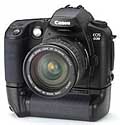 Back in late December 2000, Canon announced that it had become aware of problems with the "Auto Power Off" feature in some (but not all) early production EOS D30 digital cameras... The problem, as we understand it, is that after some EOS D30s power down they come back to life, and then the auto power off feature won't kick in until the camera has been manually switched off and back on again. Obviously, this can lead to batteries being drained if you don't notice that the camera has come back on, and so can be somewhat of an inconvenience. Back in late December 2000, Canon announced that it had become aware of problems with the "Auto Power Off" feature in some (but not all) early production EOS D30 digital cameras... The problem, as we understand it, is that after some EOS D30s power down they come back to life, and then the auto power off feature won't kick in until the camera has been manually switched off and back on again. Obviously, this can lead to batteries being drained if you don't notice that the camera has come back on, and so can be somewhat of an inconvenience.
A posting from our friends at digitalcamera.gr.jp in Japan offers some hope of a fix soon, though - Japanese users experiencing the problem are being requested by Canon to return their cameras to a service center for a repair. There's no news yet for US users, although we have heard from Canon US that they are planning a resolution at the moment. Watch this space for more as we hear it!
Source: digitalcamera.gr.jp website

Steve's Digicams posts Casio QV-3EX review!
By Michael Tomkins, The Imaging Resource
(Monday, January 29, 2001 - 14:26 EST)
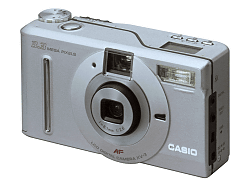
Over the weekend, the good folks at Steve's Digicams have posted a review of Casio's QV-3EX digital camera. When it was announced on February 24th 2000, The QV-3EX was billed as "the most compact 3.34 megapixel camera on the market". That's still true - but it is a very close-run thing, as the specifications in our digital camera database show... Canon's PowerShot S20, announced 2 months earlier at the very start of 2000, was close with a body some 7% larger by volume, but a significant 31% heavier than the QV-3EX. Much closer is Yashica's Finecam 3300 (September 2000), only 0.2% larger and actually some 2% lighter than the Casio. Significantly, though, both Canon and Yashica's cameras feature 2x optical zoom lenses, where the QV-3EX features a 41mm fixed focal length lens. Sony's DSC-P1 (September 2000), meanwhile, is the closest 3x zoom camera, with a chassis some 15% larger and 2.9% heavier... So what did Steve think of the QV-3EX?"The QV3EX is a total package; 3.3-megapixel camera, rechargeable battery, AC power supply and one of the highest capacity mobile storage devices available today. It is an easy to use camera with a fully automatic point-n-shoot mode as well as an aperture priority mode, a movie mode and several programmed scene modes. If you can live with the limitations of not having an optical zoom then this may just be the camera for you. If you need a zoom lens or a camera with more manual features then look at one of the other 3mpixel cameras." For the full story with lots of info on camera layout and control, as well as numerous sample photos, check out Steve's Casio QV-3EX review!
Source: Steve's Digicams website

Saturday, January 27, 2001
Steve's Digicams posts Dual-Force Pro battery pack review!
By Michael Tomkins, The Imaging Resource
(Saturday, January 27, 2001 - 14:10 EST)
 Our friends over at Steve's Digicams have today posted a review of the Dual-Force Pro NiMH Battery Pack, a cooperation between Eagle Eye and Zenon. The conclusion? Our friends over at Steve's Digicams have today posted a review of the Dual-Force Pro NiMH Battery Pack, a cooperation between Eagle Eye and Zenon. The conclusion? "This is one "healthy" battery pack to be sure! I've tested quite a few of them and the Dual-Force Pro easily gives you two to three times the run power. I took a fully charged pack and plugged it into a Casio QV-2000UX with a Microdrive and ran it with the 2-inch color LCD on the whole time. I snapped a flash picture on the average of once a minute and it ran for two hours and fifteen minutes before the first side of the pack gave out. There was still the other side left to go which is exactly the same power capacity so that means it would have lasted for better than four hours." The pack works with cameras from Casio, Ricoh, Leica, Fuji, JVC, Minolta, Nikon, Olympus and Vivitar, and costs $119. Check Steve's full review out for more on this!
Source: Steve's Digicams website

Friday, January 26, 2001
Olympus E-10 SLR Review Updated!
By David Etchells, The Imaging Resource
(Friday, January 26, 2001 - 18:19 EST)
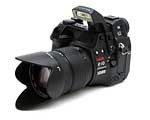 Finally, we've completed our long-overdue update of the Olympus E-10 "semi pro" SLR review. Back in October, we had the privilege of testing one of the first near-production prototypes of this exceptional camera, and have now revisited that review to reflect our experience with a full-production model. As it happens, no surprises were in store, since the production model displayed the same sterling operating characteristics as did the prototype. We did take time though, to perform timing and power consumption measurements on the production unit, with very salutary results. (We'd not done timing and power tests on the prototype, because we'd understood that the production units would have somewhat improved performance.) We don't know whether power and timing were improved or not, but the E-10's performance was certainly top-drawer! Several other open questions we'd had with the prototype also have been resolved. Check it out! Finally, we've completed our long-overdue update of the Olympus E-10 "semi pro" SLR review. Back in October, we had the privilege of testing one of the first near-production prototypes of this exceptional camera, and have now revisited that review to reflect our experience with a full-production model. As it happens, no surprises were in store, since the production model displayed the same sterling operating characteristics as did the prototype. We did take time though, to perform timing and power consumption measurements on the production unit, with very salutary results. (We'd not done timing and power tests on the prototype, because we'd understood that the production units would have somewhat improved performance.) We don't know whether power and timing were improved or not, but the E-10's performance was certainly top-drawer! Several other open questions we'd had with the prototype also have been resolved. Check it out!
Source: IR review of full-production E-10 SLR

Objectif Numerique posts Sanyo IDC-1000Z preview!
By Michael Tomkins, The Imaging Resource
(Friday, January 26, 2001 - 14:04 EST)
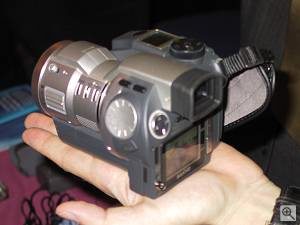
Objectif Numerique, a French-language publication of Paris-based FTPress, has posted a brief preview of Sanyo's upcoming IDC-1000Z iDshot digital camera on its website. Included in the preview is a description of the camera's interface and capabilities (English translation courtesy of Altavista's Babelfish here), as well as a number of pictures of the camera's on-screen interface (translated here).
The IDC-1000Z, initially planned for a December 8th 2000 launch, is now scheduled to ship at the beginning of February 2001. Images and video are stored on a 730MB iD PHOTO magneto-optical disk, which can fit roughly 2 hours of video recorded at 160 X 120 pixels, 15 frames per second, or about 11,000 640 x 480 pixel still images. The IDC-1000Z has a resolution of 1.5 megapixels and can capture video clips at up to 30 frames per second in 640 x 480, 320 x 200 or 160 x 120 pixel resolution. It is the first digital camera to feature both IEEE 1394 (FireWire) and USB connectivity...
Source: Objectif Numerique website

Thursday, January 25, 2001
Win an Olympus C-3000 Zoom, PSP 7 and more!
By Michael Tomkins, The Imaging Resource
(Thursday, January 25, 2001 - 22:58 EST)
 Our friends over at the PC Photo Review website have added a new feature to their site, a guide to buying a digital camera authored by J. G. Nash, an email tells us. The guide is split into 5 sections, with information on how digicams work, features to look for, and more besides. If you're looking to make the leap to digital, we'd recommend you read it - like much of the information you'll find on the well-known digital imaging sites, it could help make your buying decision an informed one, and your digital camera experience that much happier. Our friends over at the PC Photo Review website have added a new feature to their site, a guide to buying a digital camera authored by J. G. Nash, an email tells us. The guide is split into 5 sections, with information on how digicams work, features to look for, and more besides. If you're looking to make the leap to digital, we'd recommend you read it - like much of the information you'll find on the well-known digital imaging sites, it could help make your buying decision an informed one, and your digital camera experience that much happier.
Also new on the site is the latest in their series of digital photography lessons, entitled "Table Top Photography for your Web Site or Brochure". The fourth lesson promises to teach lighting and set secrets, and how to effectively crop your photos.
Finally, the site also currently has a sweepstakes running for any readers who review a digital imaging product or upload a sample image from a digital camera, which is offering an Olympus C-3000 Zoom digital camera as grand prize... The contest ends in just a few days on January 31st, 2000, so if you'd like a chance to win the digital camera, or the second and third placed prizes (JASC Paint Shop Pro 7.0 and Microsoft PictureIt! 2000 software, respectively) now is the time to get those reviews and photos submitted! Who knows - you might just win yourself a digicam instead of having to fork over the money once you've chosen which camera you want... :)
Source: PC Photo Review

Steve's Digicams posts Oly C-2040 first look!
By Michael Tomkins, The Imaging Resource
(Thursday, January 25, 2001 - 14:14 EST)
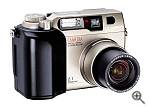 Our good friends over at Steve's Digicams have today posted a first-look review of Olympus' C-2040 Zoom digital camera, an update to the C-2020 Zoom featuring a super-bright F1.8 lens and several other changes. There's no conclusion as yet, but Steve seems pretty pleased thus far, noting: Our good friends over at Steve's Digicams have today posted a first-look review of Olympus' C-2040 Zoom digital camera, an update to the C-2020 Zoom featuring a super-bright F1.8 lens and several other changes. There's no conclusion as yet, but Steve seems pretty pleased thus far, noting:"Olympus has cranked out yet another excellent camera. Nice to see that everyone is not abandoning the two megapixel cameras but actually improving them." We couldn't agree more! Hop on over to Steve's first-look review for a lot more information on the C-2040...
Source: Steve's Digicams

Wednesday, January 24, 2001
Segmentis' buZZ filters offer digital creativity!
By Michael Tomkins, The Imaging Resource
(Wednesday, January 24, 2001 - 19:50 EST)

Looking for a new way to turn your digital images into digital art, or perhaps an alternative to that photographer's staple, the blurred background that emphasises your main subject? If so, a series of new filters compatible with Adobe Photoshop and Photo-Deluxe, as well as Jasc Paint Shop Pro, Corel Photo-Paint and others may be just what you're looking for! Segmentis' buZZ filters, available in either a Professional bundle with 13 effects or a Lite bundle with 6 effects offer budding digital artists a wide range of effects which can be applied to images for a new look. Perhaps the most impressive of the lot is the Simplifier filter, which as Segmentis describes it "removes unwanted detail from an image without loss of focus, colour, and edges, thus retaining the all-important features". The filters are be applied through what the company calls a "stack", which allows for a number of effects to be ordered sequentially, and previewed at once without altering the image, before applying the whole stack to the image in one go. The final results - such as in the picture above, which Segmentis tells us was produced in about 30 minutes, can be pretty dramatic!
Effects included in the bundles are as follows:
buZZ Lite 1.01- Simplifier One
- Edge Detect B&W
- Edge Detect Colour
- Emboss
- Radial Blur
- Radial Simplifier
buZZ Professional 1.01
All buZZ Lite filters, plus:- Simplifier Two
- Blur
- Blur More
- Radial Screen
- Spread Black
- Spread White
- Unsharp Mask
Both bundles include the "stack" through which the filters are applied... The bundles cost £54.99 and £79.99 respectively, excluding shipping costs, and can be shipped worldwide. Payment is over the web through World Pay, or by phone, fax or snail mail.
Segmentis' filters are apparently pretty well-known in England, having been awarded 9/10 points in MacFormat magazine, and 4/5 by zdnet.co.uk. The filters are compatible with both Mac and Windows systems, and a trial version limited to 20 uses can be downloaded from Segmentis' website. The samples below link to larger versions of the original (left) and retouched (right) images, whilst the sample image above links to an image showing a retouched image blended over an original image...
Source: Segmentis' website

Tuesday, January 23, 2001
Fuji Teaser, new digicam coming!
By David Etchells, The Imaging Resource
(Tuesday, January 23, 2001 - 10:55 EST)
 Fuji's Japanese site has started a digital "fan-dance", with a Flash-animated teaser starting today of a new camera planned for release soon. From the animation and limited accompanying text, it appears that the new camera will have Fuji's signature compact/upright form factor, continuing the long tradition of their pocket-cameras that began with the MX-700, and has continued to the present, last seen in the FinePix 4700, introduced last spring. Other public details are sketchy at this time, but the camera will apparently use a new SuperCCD imager chip, and will be equipped with a cradle for computer connection. Hmm, I wonder what forthcoming large photo exhibition show we might see this product at? ;-) Stay tuned for more info, as more details are released. Fuji's Japanese site has started a digital "fan-dance", with a Flash-animated teaser starting today of a new camera planned for release soon. From the animation and limited accompanying text, it appears that the new camera will have Fuji's signature compact/upright form factor, continuing the long tradition of their pocket-cameras that began with the MX-700, and has continued to the present, last seen in the FinePix 4700, introduced last spring. Other public details are sketchy at this time, but the camera will apparently use a new SuperCCD imager chip, and will be equipped with a cradle for computer connection. Hmm, I wonder what forthcoming large photo exhibition show we might see this product at? ;-) Stay tuned for more info, as more details are released.
Source: Fuji "FinePix in Spring" Teaser animation

Jeff posts Olympus E-10 review!
By David Etchells, The Imaging Resource
(Tuesday, January 23, 2001 - 10:46 EST)
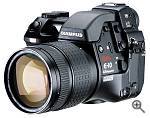 Our friend Jeff Keller over at the DCRP just sent us an email saying he's completed his review of the Olympus E-10 "semi-pro" (his term) digital SLR. Although he had some "pixel problems" with the units he tested, Jeff seemed to like the E-10 quite a bit. How much? He shelled out his own money to buy one! Check Jeff's review for all the details. (A note to all our patient readers who've been asking for the update to our own review of the E-10: We've completed the reshooting of all our test images with a full production unit, and should have the updated review text posted in a few days. (The E-10's picture-index page has already been updated with our new images and conclusions.) Our friend Jeff Keller over at the DCRP just sent us an email saying he's completed his review of the Olympus E-10 "semi-pro" (his term) digital SLR. Although he had some "pixel problems" with the units he tested, Jeff seemed to like the E-10 quite a bit. How much? He shelled out his own money to buy one! Check Jeff's review for all the details. (A note to all our patient readers who've been asking for the update to our own review of the E-10: We've completed the reshooting of all our test images with a full production unit, and should have the updated review text posted in a few days. (The E-10's picture-index page has already been updated with our new images and conclusions.)
Source: DCRP Review of the Olympus E-10 SLR

Monday, January 22, 2001
Canon posts new driver software!
By David Etchells, The Imaging Resource
(Monday, January 22, 2001 - 12:58 EST)
This just in from our friends at Canon USA: Canon has posted the following new driver software to their support website:
 | serial350.zip | 32-bit RS-232C TWAIN driver for Powershot Pro90 IS, G1, S20, S10, Pro70, A50, A5 Zoom, and A5. Card support only for EOS D30 and PowerShotS100, 350, and 600/600N. Compatible with Windows® 95/98/98SE/NT 4.0*/2000/ME. (*SP3 or higher). (3.4 MB) |  | usb350.zip | USB TWAIN driver for EOS D30 and PowerShot Pro90 IS, G1, S100, S20, S10. Card support only for PowerShot Pro70, A50, A5 Zoom, A5, 350, and 600/600N. Compatible with Windows 98/98SE/2000/ME. (2.8 MB) |  | mac350.sea | Photoshop-compatible plug-in module for EOS D30 and PowerShot Pro90 IS, G1, S100, S20, S10, Pro70, A50, A5 Zoom, and A5. Card support only for PowerShot 350 and 600/600N. Compatible with Mac OS 7.5.3 or higher, QuickTime 2.1 or higher. (2.2 MB) | It looks like this is a general upgrade to their driver software, covering essentially all their cameras to date. No mention is made of any new features, but we note that the drivers support both Windows 2000 and Windows ME. Windows ME at least seems to be posing a problem for many digicam manufacturers, given the level of email we've been receiving on the issue. Thus, welcome news that Canon's new drivers provide ME support.
(By the way, there appears to be a minor table bug on the link below, that prevents Netscape/Mac from rendering the page properly. If you see a blank page, try Internet Explorer.)
Source: Canon software download site

"Nothing Digital Lasts Forever"
By David Etchells, The Imaging Resource
(Monday, January 22, 2001 - 12:33 EST)
Thanks to IR reader "Digital Don" for pointing this one out: The Chicago Sun-Times has an article on their website discussing the longevity of digitally-archived images that could be eye-opening for some folks. If you're thinking that the CDs you're burning your images onto will last the ages, you may need to think again. The even larger problem of file format/media obsolescence is only touched on briefly by the article though: While a gold-coated CD may last 25 years, how likely is it that your PC (or your grandchildren's) will still be able to read those 2001-vintage CDs that long from now? As a measure of the pace of change, consider that twenty-five years ago, "personal computers" didn't even exist. When was the last time you had a computer that could read a 5" floppy? If you're planning for long-term archiving, you'd better also have a plan for migrating your data to newer forms of storage as you go along! Meanwhile, check out the article for some useful info on how long you can expect various forms of storage to last.
Source: Chicago Sun-Times digital archiving article

Steve Posts "First Look" and Full Reviews!
By David Etchells, The Imaging Resource
(Monday, January 22, 2001 - 12:23 EST)
Our friend Steve Sanders over at Steve's Digicams has posted a couple of new "First Looks" at the Canon Pro90 IS camera and Olympus P-200 portable photo printer. The Pro90 review is only first looks, so no detailed conclusions yet, but the P-200 review is the full product. More great work, Steve! (We have a Pro90IS in-house also, should be having a review posted on it shortly.)
Source: Steve's Digicams

Friday, January 19, 2001
Microtek announces scanner/digicam bundle!
By Michael Tomkins, The Imaging Resource
(Friday, January 19, 2001 - 13:23 EST)
 Microtek International Inc. has announced that it is now bundling its MN100 digital camera with its ScanMaker 4600 flatbed scanner. Microtek is the first company to offer a complete Internet-ready digital imaging solution with a USB scanner and digital camera combination. Microtek International Inc. has announced that it is now bundling its MN100 digital camera with its ScanMaker 4600 flatbed scanner. Microtek is the first company to offer a complete Internet-ready digital imaging solution with a USB scanner and digital camera combination.
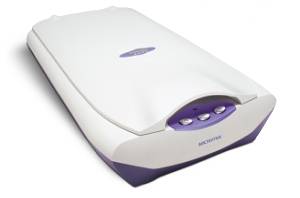 "The ScanMaker 4600 combined with our digital camera is exactly what many people have been requesting, which is full Internet imaging capabilities," said Johnathan Gerber, product specialist at Microtek. "It allows users to scan paper photographs and turn them into digital images for websites, on-line photo albums and email attachments, as well as for home projects and crafts. In addition, the hybrid MN100 also serves as a PC camera, providing the ability to communicate face-to-face in real time or to snap digital images to share with family and friends." The ScanMaker 4600 scanner features three one-touch buttons (scan, copy and email), and is compatible with both Windows or Macintosh systems. The unit has a 2400 x 1200 dpi optical resolution, 42-bit color depth, 8.5 x 11.7" scanning area, 10,600 pixel CCD sensor, USB connectivity and an expandable 'FlexScan Lid' designed for scanning bulky items, such as books or unusual size originals. An optional Microtek Transparency Media Adapter allows users to scan positive or negative film in a 7" x 7" scan area, and up to nine 35mm slides at one time. The ScanMaker 4600 bundle includes Adobe PhotoDeluxe (Mac/PC), Kodak DS Color Management (Mac/PC), Microtek Scan, Copy & Email Utilities, ScanSoft OmniPage LE (Mac/PC), ScanSoft PageKeeper Standard (PC), ScanWizard 5 (Mac/PC), Trellix Web Microtek Edition (PC), Ulead PhotoExplorer (PC), Ulead PhotoImpact Album Bundled Edition (PC) and Ulead PhotoImpact Bundled Edition (PC), as well as a USB cable and 110V power adapter.
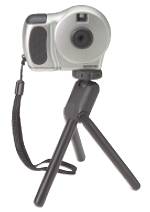 Also bundled with the ScanMaker 4600 is Microtek's MN100 digital camera, which features a 100,000-pixel CMOS image sensor, along with built-in memory to store up to twenty 352 x 288 pixel images or eighty 176 x 144 pixel images. In PC camera mode, the MN100 offers 30 frames-per-second video with audio. The camera is bundled with EyeStar Mail for PC users to record audio and video clips and send via e-mail, as well as a USB cable, carrying strap, swivel tripod and four AAA alkaline batteries. The camera has dimensions of 90 x 65 x 28mm, weighs 110 grams, has a 10-second self timer, and allows for deletion of all images in the camera at once. Microtek's advertising materials note that the MN100 has a "rapid-fire mode [that] snaps up to 80 consecutive pictures", but shot-to-shot time is not disclosed. Also bundled with the ScanMaker 4600 is Microtek's MN100 digital camera, which features a 100,000-pixel CMOS image sensor, along with built-in memory to store up to twenty 352 x 288 pixel images or eighty 176 x 144 pixel images. In PC camera mode, the MN100 offers 30 frames-per-second video with audio. The camera is bundled with EyeStar Mail for PC users to record audio and video clips and send via e-mail, as well as a USB cable, carrying strap, swivel tripod and four AAA alkaline batteries. The camera has dimensions of 90 x 65 x 28mm, weighs 110 grams, has a 10-second self timer, and allows for deletion of all images in the camera at once. Microtek's advertising materials note that the MN100 has a "rapid-fire mode [that] snaps up to 80 consecutive pictures", but shot-to-shot time is not disclosed.
The ScanMaker 4600 / MN100 bundle has an MSRP of $180.00; alternatively the scanner is available without the digital camera at a cost of $160.00. The bundle is available in the U.S.A., Canada and Latin America through distributors including Ingram Micro, Tech Data, Wynit, D&H CHS Latin America and SED, as well as retail, mail order and Internet retailers.

Thursday, January 18, 2001
Fastest Digicam in the West? (Olympus E-100RS review posted!)
By David Etchells, The Imaging Resource
(Thursday, January 18, 2001 - 21:00 EST)
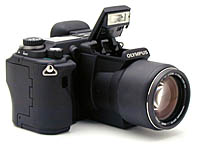 WOW! This camera is a speed demon! Read the review! As digicams mature, we expect to see more models appearing that are custom-tailored for specific application areas. The Olympus E-100RS is one of the first such, and boy, is it impressive! Olympus has combined an ultra-fast 1.5 megapixel CCD with lots of buffer memory and a 10x optically stabilized zoom lens to create what may be the ultimate digicam for sports shooting. The resolution is less than the current top of the line for prosumer cameras, but the long 10x telephoto does a lot to make up for that. Pros may niggle about autofocus speed compared to $5000 digital SLRs with $3000 lenses attached, and they'd be right: It clearly lacks the lightning-fast predictive autofocus of high-end film SLRs. At a suggested list price of $1599 and a street price somewhere around $1400 though, there's really nothing on the market even remotely close to the capabilities of the E-100RS within even several thousand dollars of it. The "RS" in the name stands for "Rapid Shot", and it's certainly that, able to capture 9 or 10 full-resolution maximum-quality files at 15 frames/second(!) and as many as 60 frames at that rate in lower resolution modes. Fifteen frames per second is a rate we previously only associated with low-res "movie" files, and one that reaches beyond the capabilities of even high-end film SLRs. Even more amazing is the E-100's ability to capture up to five images before you trip the shutter. By continuously cycling images through its buffer memory when the shutter is half-pressed in "precapture" mode, the E-100 actually has a negative shutter lag. Oh - and image quality is quite good also, including very good low light performance. Overall an amazing camera: If you need to shoot fast-moving action, this is definitely the digicam to have! Check it out! WOW! This camera is a speed demon! Read the review! As digicams mature, we expect to see more models appearing that are custom-tailored for specific application areas. The Olympus E-100RS is one of the first such, and boy, is it impressive! Olympus has combined an ultra-fast 1.5 megapixel CCD with lots of buffer memory and a 10x optically stabilized zoom lens to create what may be the ultimate digicam for sports shooting. The resolution is less than the current top of the line for prosumer cameras, but the long 10x telephoto does a lot to make up for that. Pros may niggle about autofocus speed compared to $5000 digital SLRs with $3000 lenses attached, and they'd be right: It clearly lacks the lightning-fast predictive autofocus of high-end film SLRs. At a suggested list price of $1599 and a street price somewhere around $1400 though, there's really nothing on the market even remotely close to the capabilities of the E-100RS within even several thousand dollars of it. The "RS" in the name stands for "Rapid Shot", and it's certainly that, able to capture 9 or 10 full-resolution maximum-quality files at 15 frames/second(!) and as many as 60 frames at that rate in lower resolution modes. Fifteen frames per second is a rate we previously only associated with low-res "movie" files, and one that reaches beyond the capabilities of even high-end film SLRs. Even more amazing is the E-100's ability to capture up to five images before you trip the shutter. By continuously cycling images through its buffer memory when the shutter is half-pressed in "precapture" mode, the E-100 actually has a negative shutter lag. Oh - and image quality is quite good also, including very good low light performance. Overall an amazing camera: If you need to shoot fast-moving action, this is definitely the digicam to have! Check it out!
Source: IR Review of Olympus E-100RS

HP announces retirement, new Imaging president!
By Michael Tomkins, The Imaging Resource
(Thursday, January 18, 2001 - 17:35 EST)
 Hewlett-Packard Co. has announced that Carolyn Ticknor, 53, president of HP's Imaging and Printing Systems business, will be retiring effective Feb. 1, 2001, after 24 years with the company. Vyomesh Joshi, vice president and general manager of the Inkjet Systems organization, will replace Ticknor as president of IPS. Hewlett-Packard Co. has announced that Carolyn Ticknor, 53, president of HP's Imaging and Printing Systems business, will be retiring effective Feb. 1, 2001, after 24 years with the company. Vyomesh Joshi, vice president and general manager of the Inkjet Systems organization, will replace Ticknor as president of IPS."Carolyn has made many important contributions throughout her distinguished 24-year career at HP, helping to establish the company as a pre-eminent provider of imaging and printing solutions for the home and business," said Carly Fiorina, HP chairman, president and chief executive officer. "As good leaders do, she has groomed a deep bench of senior managers who can confidently fuel HP's next phase of growth. VJ has a keen understanding of the imaging and printing business, having led our entry into the profitable, high growth Inkjet and digital imaging markets." In his new position, Joshi will have worldwide responsibility for all printing and imaging products and platforms as well as responsibility for extending HP's technology assets and intellectual property into new products and markets.
Joshi joined HP in 1980 as an R&D engineer and has held numerous leadership positions in the company's inkjet business. As the general manager of the Home Imaging Division in 1995, Joshi directed HP's entry into the digital imaging business. He also led the team that developed the first HP color inkjet cartridge. Most recently, he has led HP's Inkjet Systems business, as well as HP's latest efforts in digital imaging, including the development of HP's digital camera, photo scanner and photo printer offerings.
Source: Yahoo! Finance / BusinessWire

NuCORE chipset named in EDN 'Hot 100' list!
By Michael Tomkins, The Imaging Resource
(Thursday, January 18, 2001 - 16:05 EST)
 NuCORE Technology Inc. has announced that its digital camera chip set was named as one of EDN Magazine's '100 Hot Products of 2000'. NuCORE's NDX-1250 analog front-end and SiP1250 'Smart Image Processor' which are first told you about in July of last year are, says the company, "the industry's first chip set that delivers 3-CCD color quality to 1-CCD cameras at 50 megapixels per second". NuCORE feels the chipset, which offers 50 megapixel-per-second image processing with 12-bit resolution, enables camera manufacturers to offer cameras with professional film quality images at mainstream prices. NuCORE Technology Inc. has announced that its digital camera chip set was named as one of EDN Magazine's '100 Hot Products of 2000'. NuCORE's NDX-1250 analog front-end and SiP1250 'Smart Image Processor' which are first told you about in July of last year are, says the company, "the industry's first chip set that delivers 3-CCD color quality to 1-CCD cameras at 50 megapixels per second". NuCORE feels the chipset, which offers 50 megapixel-per-second image processing with 12-bit resolution, enables camera manufacturers to offer cameras with professional film quality images at mainstream prices."We are very honored by EDN's decision to include our chip set in their list of the 100 hot products of 2000," stated Joe Raffa, CEO of NuCORE Technology. "We are excited about the work we're doing with camera manufacturers to introduce cameras with our technology in 2001." The NuCORE chip set is claimed to be suitable for a hybrid camera capable of high-quality still images (4 megapixel at 12 frames/second) and video (1.3 megapixel at 30 frames per second), something the company feels has "never before been possible."Having one camera that can serve both functions has been regarded as the 'holy grail' of digital photography," stated NuCORE CEO Joe Raffa. "It's what digital camera makers have been trying to build, unsuccessfully. Either they build a still camera that takes a few seconds of low-resolution motion, or a motion camera that takes poor quality stills that are unsuitable for photo printing. No other chip maker has been able to give them a solution that can do both, until now." EDN Magazine is a fortnightly industry publication from business publisher Cahners. The Hot 100 Products list was started in 1993 and has been held annually since... It features sections including Communications, Digital ICs, Embedded-development tools, Computers, boards, and buses, Test & measurement, 'Components, hardware, and interconnect', Software, EDA tools, Processors, Analog ICs and discretes, Peripherals, Power sources/controllers, and Multimedia functions, of which NuCORE was chosen in the final category. The full list of 100 products can be found in the December 7th issue of EDN Magazine.
Source: Yahoo! Finance / BusinessWire

digitalkamera.de posts Olympus E-10 review!
By Michael Tomkins, The Imaging Resource
(Thursday, January 18, 2001 - 11:15 EST)
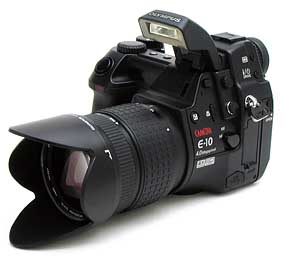
Our friends in Germany at the digitalkamera.de website have now posted their review of Olympus' E-10 digital camera... Here's some of their feelings:"The Olympus Camedia E-10 will without a doubt fulfil the demands of the semi-professionals, yes, and even the professionals. For about 2,250 EUR the camera offers almost everything that one could hope for in this price class, except the removable lens. E-10's fixed lens covers a focal range that is especially interesting for portrait and studio photographers (still life, pack-shots). For sport, news, and action photography the E-10 is not as suitable, even with the optional available tele converters. The E-10 takes too long to turn on and display images for these fields of photography.
But the E-10 is not exactly cheap ... at a price of 2,250 EUR, and fully equipped with accessories the price can easily be doubled. Then it is hard to overlook little (and big) flaws, which one might do with a consumer digital camera that cost half the price." For the whole story along with a couple of sample photos from the camera and the usual gorgeous pictures of the camera body and accessories, check out the full review...
Source: digitalkamera.de website

Tuesday, January 16, 2001
We have a winner! ($500 in free prints!)
By David Etchells, The Imaging Resource
(Tuesday, January 16, 2001 - 18:11 EST)
Congratulations to reader Richard Bourassa, of Winter Springs, Florida! His name came up the winner in the sweepstakes sponsored by advertiser Printroom.com over the last 2 months, to promote their new "Shoot & Share" image organizing & uploading application. (Shoot & Share not only organizes your images, but lets you adjust, crop, rotate, and eliminate red-eye as well.) In exchange for taking a minute to fill out a brief survey form, Richard's won $500 (!) of free printing services from Printroom.com. His $500 of free printing is good for any of the services Printroom offers, including prints up to 8x10 inches in size. Thanks to all the IR readers who participated in this sweepstakes, and congratulations again to Richard on his prize. (Stay tuned for more IR sweepstakes in the future - You, too, could be a winner!)

DPReview posts Olympus E-10 review!
By Michael Tomkins, The Imaging Resource
(Tuesday, January 16, 2001 - 17:14 EST)
 Our friends at the Digital Photography Review have just posted their full review of Olympus' E-10 digital camera, which is as in-depth as is usual for their reviews... Here's Phil's conclusion on the first 4 megapixel camera released: Our friends at the Digital Photography Review have just posted their full review of Olympus' E-10 digital camera, which is as in-depth as is usual for their reviews... Here's Phil's conclusion on the first 4 megapixel camera released:"Without a doubt the E-10 offers excellent value for money. Even with it's US$1,950 list price it's still a good US$1,500 cheaper than it's nearest "professional" rivals, yet it steps up and takes them on for overall image quality, build and features. The E-10 looks and feels like a professional tool, to a certain degree it also performs as one, probably only let down by it's slow "digital side", the processing, buffering and writing of images.
The camera isn't without a few problems but none of these are great cause for concern, nor reasons not to go for the E-10, my only current niggle is the experience of other E-10 buyers who have had stuck pixel and other QC problems (some are even on their second or third E-10 - which is why I could only give the camera a 9 for value for money, it was certainly getting close to a 10).
If some of the speed issues and the lack of an interchangeable lens aren't big issues to you and you don't already own bags of 'one brand' equipment then the E-10 should certainly be near the top of your list. Value for money? You bet." Be sure to check out the full review along with numerous sample images, pictures of the camera itself and comparisons with rival cameras...
Source: Digital Photography Review

Epson announces two new photo printers!
By Michael Tomkins, The Imaging Resource
(Tuesday, January 16, 2001 - 14:06 EST)
 Epson America Inc. has announced two new four-color ink jet printers that the company says are "designed for brilliant photo-quality output with sleek, eye-catching exteriors designed to accentuate Apple's iMac and PowerMac G4 computers". The Epson Stylus Color 83 and Stylus Color 880i are aimed at home, education or business users, and feature up to 2880 x 720 dpi resolution, four-picoliter droplet size, and print speeds of up to 12 pages per minute (ppm) in black text and up to nine ppm for text and color graphics. Epson America Inc. has announced two new four-color ink jet printers that the company says are "designed for brilliant photo-quality output with sleek, eye-catching exteriors designed to accentuate Apple's iMac and PowerMac G4 computers". The Epson Stylus Color 83 and Stylus Color 880i are aimed at home, education or business users, and feature up to 2880 x 720 dpi resolution, four-picoliter droplet size, and print speeds of up to 12 pages per minute (ppm) in black text and up to nine ppm for text and color graphics.
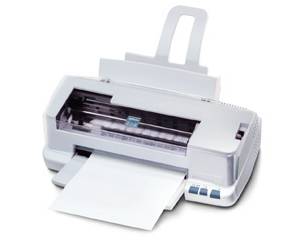
Priced at $199 (and with a $30 mail-in rebate available), the Stylus Color 83 features a clear lid with dark turquoise buttons and paper trays to compliment the design of Apple's Power Mac G4 Cube. Customers who purchase a Stylus Color 83 will also receive a coupon in the box for a free matching printer stand. The Stylus Color 880i is priced at $149 and offers an 'ice' exterior case with a transparent graphite lid."These printers basically give consumers everything they could ask for and more in affordable all-purpose printers," said Andreas Goehring, product manager, consumer ink jet printers, Epson. "They provide outstanding photographic images, sharp text documents, quiet operation for less distraction, they're easy to use and feature attractive designs that would look cool in anybody's home or office." Both printers feature Epson's 'Advanced Micro Piezo' and 'AcuPhoto Halftoning' technologies, as well as quick-drying inks that are claimed to eliminate smudging and bleeding. Epson notes that both printers have "been engineered for greater saturation, improved shadows and highlights that result in intense detail".
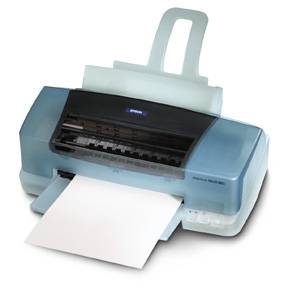
Setup and operation is, says Epson, "simplified by onscreen, animated 'Fix-It Flix' that are designed help users troubleshoot without having to refer to a manual". Both printers are compatibile with Mac and Windows platforms, feature both USB and parallel connectivity and come with a software bundle that includes Epson Film Factory (for collecting and organizing digital photos), Trellix Web (for creating personalized Web sites), ArcSoft Photo Impression 2000 (for editing, enhancing, retouching or adding special effects to images) and ArcSoft Photo Montage (for creating a 'montage' of a single image from a collection of thousands of micro images).
The EPSON Stylus Color 83 and Stylus Color 880i are currently available through the Apple Store and retail stores nationwide. Both printers carry a one-year Epson Exchange Limited Warranty, enabling customers to receive a replacement printer if a problem cannot be corrected by telephone technical support...

Monday, January 15, 2001
Verbatim unveils CF, SmartMedia lineups!
By Michael Tomkins, The Imaging Resource
(Monday, January 15, 2001 - 17:56 EST)
 Verbatim Corp. has today unveiled two new flash card product lines. Verbatim's new flash cards are CompactFlash cards with capacities ranging from 16MB to 128MB, and SmartMedia cards with capacities of 16MB to 64MB. Verbatim is targetting the two new lines at digital cameras, audio players, camcorders, PDAs and 'smart' cellular phones. Verbatim Corp. has today unveiled two new flash card product lines. Verbatim's new flash cards are CompactFlash cards with capacities ranging from 16MB to 128MB, and SmartMedia cards with capacities of 16MB to 64MB. Verbatim is targetting the two new lines at digital cameras, audio players, camcorders, PDAs and 'smart' cellular phones."Digital camera usage is the driving force in the Flash Memory Card market," said Ronan Ryan, Verbatim Director of Business Development. "Like the CD-Recorder, the digital camera is a true convergence product, uniting the Consumer Electronics and PC data storage businesses. Digital camera prices are coming down, making their benefits easier to justify, but many of today's digital cameras require Megabytes of removable storage for each image in the highest resolution mode. We're committed to providing these users and other portable digital appliance users with a low-cost way to expand their storage capacity and their enjoyment of these devices." Ryan added that Verbatim will introduce adapter and reader product lines later in Q1 and also intends to add other Flash memory form factors later in the year. All products will be supported by Verbatim's Lifetime Warranty and Toll-free Technical Support.
Source: Yahoo! Finance / Business Wire

New version (v1.3) of MacBibble released!
By Michael Tomkins, The Imaging Resource
(Monday, January 15, 2001 - 17:32 EST)
Eric Hyman, author of the superb PC imaging utility Bibble and its Macintosh counterpart MacBibble, has yesterday released a new version of the latter program. MacBibble v1.3 extends support for the Canon EOS D30's .CRW CCD-RAW files, adds FireWire support and new file management functionality, improves interpolation, and fixes a number of bugs.
Here's a full list of changes:- *NEW* Firewire support for direct tethered shooting to your power Mac form the D1.
- *NEW* File-management functions in the browser, copy/move/delete/batch. From menu, or right click.
- *NEW* Improved interpolation method for better quality (less fringing, better color)
- Fixed clipping in browser window and made panes resizable.
- Fixed numerous crashes and problems with noise removal with previews.
- Fixed problems with filenames containing more than one period.
- Fixed problem with curves points not dragging.
- Fixed crashes and bad previews in curves.
- Fixed many many memory leaks specific to the Mac version.
- Fixed Colorspace problem with saving 8-bit tiffs.
- Fixed problems leading to occasional inconsistent options.
- Fixed problem with rotated previews.
- Fixed problems with batches including crashes.
- Fixed incorrect file types on Jpegs. (Were labeled as .tifs)
- Fixed temporary files being left on desktop.
If you're a Nikon D1 owner, you really should try MacBibble out... ;) Visit the Bibble Labs website to download the current version.
Source: Bibble Labs website

New version (v11.01) of Qimage Pro released!
By Michael Tomkins, The Imaging Resource
(Monday, January 15, 2001 - 17:24 EST)
 Our good friend Mike Chaney has released a new version of his popular image viewing/printing/editing application, Qimage Pro. The latest release, v11.01, reduces batch filter memory requirements, increases redraw speed on the preview page, fixes a number of bugs, and adds an 'Optimize' button that is designed to save paper and ensure you're printing with the optimum page or image orientation and layout... Hop on over to the Qimage Pro website to grab the latest version and give it a spin! Our good friend Mike Chaney has released a new version of his popular image viewing/printing/editing application, Qimage Pro. The latest release, v11.01, reduces batch filter memory requirements, increases redraw speed on the preview page, fixes a number of bugs, and adds an 'Optimize' button that is designed to save paper and ensure you're printing with the optimum page or image orientation and layout... Hop on over to the Qimage Pro website to grab the latest version and give it a spin!
Source: Qimage Pro website

Fuji FinePix S1 Pro user review posted!
By Michael Tomkins, The Imaging Resource
(Monday, January 15, 2001 - 15:33 EST)
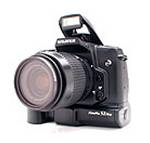 IR reader Lasse Swärd has posted a user review of his Fuji FinePix S1 Pro digital camera on his website, an email tells us. Lasse seems very happy with the camera, and has posted quite a few images he's taken with it to show what it can be capable of. If you're considering the S1 Pro, check out Lasse's feelings to get an idea of what you can expect! Thanks, Lasse! IR reader Lasse Swärd has posted a user review of his Fuji FinePix S1 Pro digital camera on his website, an email tells us. Lasse seems very happy with the camera, and has posted quite a few images he's taken with it to show what it can be capable of. If you're considering the S1 Pro, check out Lasse's feelings to get an idea of what you can expect! Thanks, Lasse!
Source: Lasse Swärd's Fuji FinePix S1 Pro user review

Outback Photo looks at Olympus P-400!
By Michael Tomkins, The Imaging Resource
(Monday, January 15, 2001 - 15:11 EST)
Our friend Uwe Steinmuller over at the Digital Outback Photo website has posted a brief user review of Olympus' P-400 photo printer. The conclusion? "From the beginning this printer was fun to use and after the profiling even more so. Highly recommended." Thanks, Uwe!
Source: Digital Outback Photo website

PrintLife announces two-for-one PhotoBook offer!
By Michael Tomkins, The Imaging Resource
(Monday, January 15, 2001 - 14:11 EST)
 We've mentioned once or twice before on the news page an interesting service from a company called PrintLife.com, which offers the ability to turn your digital images into customised hardback books... We were interested to see, then, that PrintLife (an Israeli company) has now officially launched the service in the USA and is currently running a special offer to celebrate their launch! We've mentioned once or twice before on the news page an interesting service from a company called PrintLife.com, which offers the ability to turn your digital images into customised hardback books... We were interested to see, then, that PrintLife (an Israeli company) has now officially launched the service in the USA and is currently running a special offer to celebrate their launch!
Through the end of January, readers who order a PhotoBook through PrintLife's service will receive a free duplicate of the PhotoBook to give to family and friends if the order is placed with the code "GIVEONE7". The book is created with a free program called PhotoBook Publisher, which can either be downloaded from PrintLife's website, or mailed to you free of charge if you prefer. An alternative (which offers less customisation) is to create the book online...
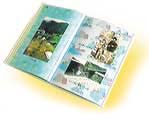 Each 10.5" x 7" PhotoBook consists of 8 double-sided glossy photo-paper pages, which can hold up to 40 images depending on size and layout. Different backgrounds and layouts can be selected for each page, and captions added to photos to help tell the story. The book's hard cover can also be printed on, allowing you to place titles and selected images on the cover, and also to put text describing the book along the spine. Each 10.5" x 7" PhotoBook consists of 8 double-sided glossy photo-paper pages, which can hold up to 40 images depending on size and layout. Different backgrounds and layouts can be selected for each page, and captions added to photos to help tell the story. The book's hard cover can also be printed on, allowing you to place titles and selected images on the cover, and also to put text describing the book along the spine.

Lone Star Digital server move
By Michael Tomkins, The Imaging Resource
(Monday, January 15, 2001 - 11:51 EST)
Our friend John Cowley over at the lonestardigital.com website has been in touch to let us know he's moving servers to a new, high bandeitdh server. In the midst of his move, it will take a little while to propagate his new address across the internet, and so readers may find that they cannot get to his site at the usual address. Everything should be back to normal by around January 17th, but in the meantime you can find John's site by IP address instead...

Sunday, January 14, 2001
Digital Eye CES photos posted!
By Michael Tomkins, The Imaging Resource
(Sunday, January 14, 2001 - 12:13 EST)
As promised in our previous news item "DataPlay wins two TechTV awards" of last Friday, our friends over at the Digital Eye website have now posted further pictures from the Consumer Electronics Show 2001 in Las Vegas, Nevada. Included in the pictures are several concept digital camera designs, including a Toshiba PDR-M70 modified to accept DataPlay discs (and promising 400 still images or 30 minutes of MotionJPEG video on one disc), as well as another rather radically designed digicam and a mobile picture viewer from Toshiba. There's also the SmartDisk MediaStore, which copies files from flash cards to DataPlay discs, an unidentified (but extremely curvy) camera mockup, and more...
Source: Digital Eye website

Saturday, January 13, 2001
Full review posted for Ricoh RDC-6000!
By David Etchells, The Imaging Resource
(Saturday, January 13, 2001 - 22:55 EST)
 This must be the week for entry-level two megapixel cameras. Today, we've posted a review of Ricoh's RDC-6000 entry-level unit. This model is designed to sell for less than the PDR-M60 we posted on the 12th, but also lacks an optical zoom lens. It does offer some interesting capabilities though, including a time-lapse photography option, and the ability to function as a web cam. (Additional third-party software needed for web cam operation though.) Check it out! This must be the week for entry-level two megapixel cameras. Today, we've posted a review of Ricoh's RDC-6000 entry-level unit. This model is designed to sell for less than the PDR-M60 we posted on the 12th, but also lacks an optical zoom lens. It does offer some interesting capabilities though, including a time-lapse photography option, and the ability to function as a web cam. (Additional third-party software needed for web cam operation though.) Check it out!
Source: IR review of Ricoh RDC-6000

Friday, January 12, 2001
DataPlay wins two TechTV awards!
By Michael Tomkins, The Imaging Resource
(Friday, January 12, 2001 - 19:23 EST)
Our friends over at the Digital Eye website attended the Consumer Electronics Show held recently in Las Vegas, Nevada, and have posted a couple of interesting items from the show floor... First up is an item on the long-awaited DataPlay storage media, which we first told you about in April 2000. DataPlay discs are small optical discs which have a capacity of 500MB, and can be written to one time. Each disc will cost about $10 according to Dataplay's website... DataPlay received two awards from TechTV for their new media, Best of Show in the Mobile Device category, and Best Overall Lifestyle Product. Pictured below is DataPlay Chairman, Steve Volk, holding a DataPlay disc with his two TechTV awards in front of him - thanks to David Kamanski at the Digital Eye for allowing us to use the picture!

Also from Digital Eye come a number of photos of Canon's PowerShot Pro90 IS, which was announced and first shown in public at CES. David has also promised to add pictures of DataPlay product mockups including a Toshiba digital camera, amongst others, to the site shortly...
Source: Yahoo! Finance / Business Wire

PC Photo Review Holiday Photo Contest almost over!
By Michael Tomkins, The Imaging Resource
(Friday, January 12, 2001 - 17:15 EST)
 The folks at the PC Photo Review website have been in touch today to remind readers that their Holiday Photo Contest is almost over. There are 87 entries currently, with the contest seeking photos that "capture the spirit of the Holiday season" - and they needn't be from 2000, either. The contest runs through January 15th, and prizes include a copy of CompuPic Pro for the winner, and 1 year subscriptions to digitalFoto Magazine for two runners up... The folks at the PC Photo Review website have been in touch today to remind readers that their Holiday Photo Contest is almost over. There are 87 entries currently, with the contest seeking photos that "capture the spirit of the Holiday season" - and they needn't be from 2000, either. The contest runs through January 15th, and prizes include a copy of CompuPic Pro for the winner, and 1 year subscriptions to digitalFoto Magazine for two runners up...
With three prizes and just under 90 entries, your chances of winning are currently about 1 in 30... Those are some pretty good odds, so what are you waiting for? Hop on over to the PC Photo Review website, and submit your own seasonal photo. :)
Source: PC Photo Review

Altamira alive and well, only their web server isn't!
By David Etchells, The Imaging Resource
(Friday, January 12, 2001 - 16:10 EST)
 I had no idea how many people were reading our review of Altamira's Genuine Fractals software package, until their site went down! - Altamira Group has been having severe web server (DNS) problems this week, and I've been inundated with emails from people looking for their server, hoping to download a trial copy of the package. I called Altamira out in California today, and learned that they are indeed alive and well, but are having a particularly rocky transition to a new hosting provider. Their domain name madness will hopefully be sorted out by next week at the latest, but in the meantime, here's a temporary link to the Altamira Group's web site. I had no idea how many people were reading our review of Altamira's Genuine Fractals software package, until their site went down! - Altamira Group has been having severe web server (DNS) problems this week, and I've been inundated with emails from people looking for their server, hoping to download a trial copy of the package. I called Altamira out in California today, and learned that they are indeed alive and well, but are having a particularly rocky transition to a new hosting provider. Their domain name madness will hopefully be sorted out by next week at the latest, but in the meantime, here's a temporary link to the Altamira Group's web site.
Source: Temporary address for Altamira web server

Full review posted for Toshiba PDR-M60
By David Etchells, The Imaging Resource
(Friday, January 12, 2001 - 7:56 EST)
 Toshiba has been making progressive inroads in the digicam field for some time now, and now have a nice entry-level 2 megapixel model (with 2.3x optical zoom lens) in the form ot their PDR-M60. We finally laid hands on one of these, and found that it produced good images, with enough controls to handle normal shooting conditions. It also carries the trademark Toshiba speed into the realm of inexpensive cameras, with cycle times of just over 2 seconds at full resolution. All in all, a pretty nice package. Check it out! Toshiba has been making progressive inroads in the digicam field for some time now, and now have a nice entry-level 2 megapixel model (with 2.3x optical zoom lens) in the form ot their PDR-M60. We finally laid hands on one of these, and found that it produced good images, with enough controls to handle normal shooting conditions. It also carries the trademark Toshiba speed into the realm of inexpensive cameras, with cycle times of just over 2 seconds at full resolution. All in all, a pretty nice package. Check it out!
Source: IR review of Toshiba PDR-M60

Digital Imaging Takes Over Macworld Expo
By Mike Pasini, The Imaging Resource
(Friday, January 12, 2001 - 1:47 EST)
Neither snow, sleet, thunder, lighting (well, rain, anyway) could keep Mike Pasini, editor of the Imaging Resource Digital Photography Newsletter, from the floor of Macworld Expo 2001 in San Francisco.
Today's report covers everything from inkjet printers to portable storage (for that prolonged vacation he's dreaming about) to inexpensive color calibration.

Thursday, January 11, 2001
FULL review of Olympus P-400 sub-$1,000 dye-sub printer!
By David Etchells, The Imaging Resource
(Thursday, January 11, 2001 - 22:51 EST)
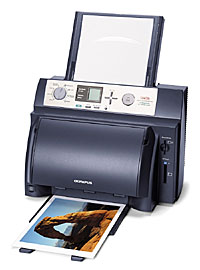 Olympus' remarkable sub-$1,000 dye-sublimation printer proved to be a worthy subject for our first in-depth printer review: It displayed excellent print quality, print speeds far exceeding photo-quality inkjets, and even has a lower media cost than most inkjets to boot. Olympus' remarkable sub-$1,000 dye-sublimation printer proved to be a worthy subject for our first in-depth printer review: It displayed excellent print quality, print speeds far exceeding photo-quality inkjets, and even has a lower media cost than most inkjets to boot.
We've wanted for some time to begin covering printers, but were stymied as to how to present the sort of objective performance data for printers that has been the hallmark of our camera reviews. Photo printing is a complex process, and printer characteristics can vary in strange ways across the range of color and tonality. We think we've found at least a partial solution in some graphics technology we've uncovered, that lets us look at printer color spaces both two-dimensionally (a plot of the maximum extent of the color gamut, and also three-dimensionally, as shown below. (That's a plot of the P400's overal color gamut, or range of reproducible colors, as compared to a standardized web-offset printing press profile. Read the P-400 review for all the details.)
 We'll have more absurdly detailed photo printer reviews for you as the year goes on, but for now, can confidently say that the P-400 is an outstanding bargain, truly breaking the mold of what we've come to expect for dye-sub printing. (Big bucks, sluggish performance has turned into affordable bucks, great performance) Check it out! We'll have more absurdly detailed photo printer reviews for you as the year goes on, but for now, can confidently say that the P-400 is an outstanding bargain, truly breaking the mold of what we've come to expect for dye-sub printing. (Big bucks, sluggish performance has turned into affordable bucks, great performance) Check it out!
Source: IR Review of P-400 Printer

Megapixel January issue online!
By Michael Tomkins, The Imaging Resource
(Thursday, January 11, 2001 - 15:50 EST)
 The good folks over at the bilingual Megapixel.net website have now posted their January 2001 issue... Reviews this month include the Sony DSC-P1, Canon Powershot G1, Casio QV-2300UX and Toshiba PDR-M60 digital cameras. There's also an article describing how digital cameras can record time, date and other information without damaging your images, some suggestions for travelling with your digital camera, and a gallery of Macro and Close-up photos. The good folks over at the bilingual Megapixel.net website have now posted their January 2001 issue... Reviews this month include the Sony DSC-P1, Canon Powershot G1, Casio QV-2300UX and Toshiba PDR-M60 digital cameras. There's also an article describing how digital cameras can record time, date and other information without damaging your images, some suggestions for travelling with your digital camera, and a gallery of Macro and Close-up photos.
Source: Megapixel.net

Agfa announces Duoscan f40 dual-bed scanner!
By Michael Tomkins, The Imaging Resource
(Thursday, January 11, 2001 - 12:01 EST)
 Agfa-Gevaert N.V. has announced the first of its new line of TwinPlate scanners, the DuoScan f40. The 42-bit DuoScan f40 features IEEE1394 FireWire and USB connectivity, separate beds for scanning reflective and transparent originals, glass-free slide holders and a software bundle that Agfa feels "makes the DuoScan f40 as attractive to entry-level graphics professionals as it is to the more experienced user". Agfa-Gevaert N.V. has announced the first of its new line of TwinPlate scanners, the DuoScan f40. The 42-bit DuoScan f40 features IEEE1394 FireWire and USB connectivity, separate beds for scanning reflective and transparent originals, glass-free slide holders and a software bundle that Agfa feels "makes the DuoScan f40 as attractive to entry-level graphics professionals as it is to the more experienced user".
The DuoScan f40 features an optical resolution of 1200 x 2400 ppi, 42-bit colour depth and a dynamic range of 3.0 D. Using FotoLook software the resolution can be interpolated to 4800 x 4800 ppi. The reflective scanning area is A4/legal with a 203 mm x 254 mm / 8x10-inch transparency scanning area. In addition to its newest version of FotoLook scanning driver and ColorTune colour-management software, Agfa includes Adobe Photoshop LE and I.R.I.S. ReadIris optical character recognition software."DuoScan has been the choice of photographers and designers because of its exceptional quality capabilities," said Per Säve, vice president, Agfa Consumer Digital Imaging. "With the DuoScan f40 we are bringing entry-level and home office users many of the same features enjoyed by experienced professionals. It comes to them in a package that is convenient and easy to use. And by providing both a FireWire and USB interface, they also enjoy fast plug-and-play data transmission whether they use a Mac or a PC." Agfa includes glass-free holders for 35-mm framed, 35-mm filmstrip, 6 x 9 cm and 4 x 5-inch transparencies, and flexible transparency frames for use with the separate slide-in glass plate. In addition to FotoLook 3.5 scanning software and ColorTune colour-management software, the f40's software bundle includes Adobe Photoshop 5.0 Limited Edition and Iris ReadIris OCR software, an optical character recognition program which recognizes 55 languages. FotoLook 3.5 offers features such as smart unsharp masking, automatic and manual black and white point settings, batch scanning functionality, and CIElab support and selective colour correction for the Mac. Agfa claims that its TFS technology makes the DuoScan f40 "an excellent choice for negative scanning". Other functions of FotoLook include variable descreening for scanning halftone images, gradation curves, and gamma and colour cast correction. Agfa ColorTune meanwhile includes generic scanner profiles, a reflective IT8 colour calibration chart and a range of ICC-compatible device profiles for color matching. ColorTune also allows users to create their own customised scanner profiles.
The DuoScan f40 will be available February 2001 at the manufacturer's suggested street price of $999.
| Agfa DUOSCAN f40 |
|---|
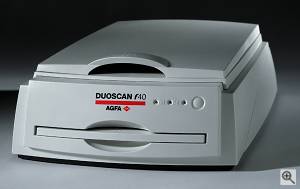 | | General |
|---|
| Model Number: | DUOSCAN f40 | | Retail Price: | $999 | | Date Available: | February 2001 | | Scanning Hardware |
|---|
| Media Type: | A4 / legal reflective media, transparencies up to 8 x 10 inches | | Reading Resolution: | 1200 x 2400 dpi optical resolution | | Film adapter: | - 35mm framed (glassless)
- 35mm film strip (glassless)
- 6 x 9 cm (glassless)
- 4 x 5 inch (glassless)
- Flexible transparency frames for use with separate slide-in glass plate
| | Scanning area: | Separate scanning beds for reflective and transparent media:
- Reflective: 216 x 356 mm (8.5 x 14 inch)
- Transparency: 203 x 254 mm (8 x 10 inch)
| | Scanning and Processing |
|---|
| Dynamic Range: | 3.0 D | | Output Data: | 42-bit, 14-bits per color channel | | Interpolation: | Up to 4800 x 4800 dpi interpolated using Agfa FotoLook software | | Color Management: | Agfa ColorTune software. Allows use of generic or custom scanner profiles, includes IT8 color calibration chart and a range of ICC profiles for color matching | | Data Transfer & Software |
|---|
| Scanning Software: | - Agfa FotoLook 3.5
- Agfa ColorTune
- Adobe Photoshop 5.0LE
- Iris ReadIris OCR
| | Interface: | USB and IEEE 1394 (FireWire) |
Source: Agfa website

Wednesday, January 10, 2001
Aunt Abigail brings albums back to the living room!
By Michael Tomkins, The Imaging Resource
(Wednesday, January 10, 2001 - 15:52 EST)
 An email from Canadian software author Stan Mlynek tells us of a program he currently has in Beta testing, "Aunt Abigail's Photo Album". The program, apparently inspired by an aunt (real or mythical, we don't know!) who only likes looking at photos on paper, is a Windows-only album printing application. Photos placed in an album can be cropped, resized, and have special effects applied to them (such as embossing), and the original images aren't altered. Images can be captioned, and albums are automatically saved as they are modified. The results can then be printed on your photo-printer, and turned into an honest-to-goodness photo album even Aunt Abigail would approve of. Aunt Abigail's Photo Album works on Microsoft Windows 95/98/ME and NT4/2000, and is currently free during the second phase of Beta testing. An email from Canadian software author Stan Mlynek tells us of a program he currently has in Beta testing, "Aunt Abigail's Photo Album". The program, apparently inspired by an aunt (real or mythical, we don't know!) who only likes looking at photos on paper, is a Windows-only album printing application. Photos placed in an album can be cropped, resized, and have special effects applied to them (such as embossing), and the original images aren't altered. Images can be captioned, and albums are automatically saved as they are modified. The results can then be printed on your photo-printer, and turned into an honest-to-goodness photo album even Aunt Abigail would approve of. Aunt Abigail's Photo Album works on Microsoft Windows 95/98/ME and NT4/2000, and is currently free during the second phase of Beta testing.
Source: Aunt Abigail's Photo Album website

Microtech announces rugged flash storage cases!
By Michael Tomkins, The Imaging Resource
(Wednesday, January 10, 2001 - 15:14 EST)
 Microtech Int'l Inc. has announced a new line of flash card storage cases, by the name of MediaVault. The company says that its MediaVault line is superior to nylon or neoprene cases because the cases are constructed using an inner rigid frame and shock absorbing rubber liner. Microtech Int'l Inc. has announced a new line of flash card storage cases, by the name of MediaVault. The company says that its MediaVault line is superior to nylon or neoprene cases because the cases are constructed using an inner rigid frame and shock absorbing rubber liner.
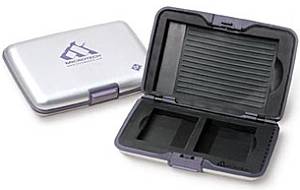
The cases feature an outer aluminum shell claimed to "shield media cards against excessive heat build-up from direct sunlight and damage from x-ray, radio frequency and electromagnetic waves". They also feature a latching mechanism to prevent them from opening unexpectedly."When we looked at the market we found there was no product available offering a high level of protection to valuable digital media cards," said Al Conte, director of product development at Microtech. "That's why we wanted to create these armored digital media carriers, so that accidents and malfunctioning airport x-ray machines cannot destroy irreplaceable vacation photos or important data stored on your digital media." The MediaVault is available for CompactFlash Type-I and II (including the IBM Microdrive), SmartMedia, MultiMediaCard, MemoryStick and PC Card flash media. The CompactFlash MediaVault holds two CompactFlash Type I or II cards and a PC Card adapter. The SmartMedia, MultiMediaCard, and MemoryStick MediaVault each hold four cards and a PC Card adapter. The PC Card MediaVault holds two full-size PCMCIA cards. All of the MediaVault cases are available immediately and priced at $19.95 each.
Source: Microtech website

New version (1.2.0) of ImageBuddy released!
By Michael Tomkins, The Imaging Resource
(Wednesday, January 10, 2001 - 12:32 EST)
 Jeff Thoman of KepMad Systems was in touch a few days ago, with news that he's released a new version of ImageBuddy, the Macintosh image-viewing/printing application. ImageBuddy v1.2.0 adds drop shadows and two-line captions to contact sheets, adds support for colored backgrounds and adjustable margins, and allows page layouts to be fine-tuned with the arrow keys in manual mode. There's also a few more small changes, and 7 bug fixes... Jeff Thoman of KepMad Systems was in touch a few days ago, with news that he's released a new version of ImageBuddy, the Macintosh image-viewing/printing application. ImageBuddy v1.2.0 adds drop shadows and two-line captions to contact sheets, adds support for colored backgrounds and adjustable margins, and allows page layouts to be fine-tuned with the arrow keys in manual mode. There's also a few more small changes, and 7 bug fixes...
ImageBuddy is available from the KepMad website and costs $15 to register... The program is for Macintosh only, and there are currently no plans for a Windows version.
Source: ImageBuddy website

Tuesday, January 9, 2001
Kodak announces Pro camera bundles!
By Michael Tomkins, The Imaging Resource
(Tuesday, January 9, 2001 - 22:26 EST)
 Eastman Kodak Co. has announced that it is now offering three of its Kodak Professional digital cameras, along with its 8660 thermal printer and software in packaged bundles, at a cost of up to 33% below the list prices for the individual components. Eastman Kodak Co. has announced that it is now offering three of its Kodak Professional digital cameras, along with its 8660 thermal printer and software in packaged bundles, at a cost of up to 33% below the list prices for the individual components."There's no question that digital imaging is a growing photographic segment. But cost and some uncertainties about what equipment is needed have slowed many independent portrait and event photographers from entering the digital world," said John Hodgson, Marketing Manager, Kodak Professional. "We're removing those barriers by offering a range of reliable digital imaging solutions in pre-selected bundles so photographers can choose one that best fits their needs, expertise and budget." Kodak Professional is offering a total of six different solutions. The bundles with a Kodak Professional DCS 330 and DCS 520 digital cameras are available only while supplies last, while the other bundles are available until June 30, 2001. The bundles are available only from authorized Kodak Professional Portraits & More dealers, and are as follows:
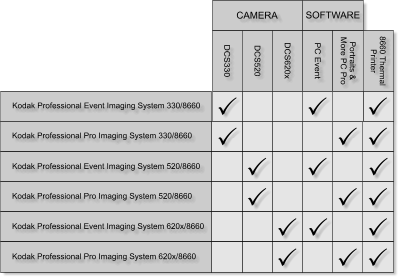
The 8660 thermal printer included in each bundle features a cast metal frame and a cartridge thermal ink ribbon for easy media loading. It delivers photo-quality output from 5x7 inches up to a full page 8.5x14 inches. The DCS 330 camera, built on a Nikon Pronea SLR platform, offers 3-megapixel resolution, and has an ISO range of 125-400, 10-bit color range and a built-in anti-aliasing filter. The Kodak Professional DCS 520 and DCS 620x digital cameras, meanwhile, are built on a Canon EOS-1N platform and a Nikon F5 platform respectively. They feature 2-megapixel image resolution, 12-bit color depth and removable anti-aliasing filters. The ISO rating for the DCS 520 camera is 200-1600, while for the DCS 620x camera it is 400-4000.
Kodak Professional Portraits & More software, comes in two different configurations available in these bundles - PC Event and PC Pro. Both are Windows-based and provide image processing, graphic template merging, and package printing. They also offer the option of adding text to images. PC Event software is designed for portraiture, where fewer creative choices are needed to keep people moving through a portrait sitting. PC Pro software offers a range of artistic options such as multi-image composites, and is suitable for senior portraiture and executive portraiture.

Macworld Expo Special Report
By Mike Pasini, The Imaging Resource
(Tuesday, January 9, 2001 - 21:22 EST)
Catch our Special Report by Mike Pasini, editor of the Imaging Resource Digital Photography Newsletter, from the floor of Macworld Expo 2001 in San Francisco.
Today's report analyzes Steve Jobs' keynote address and highlights Apple's product introductions with photo coverage.

UPDATED Nikon announces three new scanners with ICE, ROC and GEM!
By Michael Tomkins, The Imaging Resource
(Tuesday, January 9, 2001 - 12:08 EST)
Nikon has today unveiled a new line of high-speed desktop scanners, the Coolscan IV ED, Super Coolscan 4000 ED and Super Coolscan 8000 ED. All three scanners include Applied Science Fiction’s Digital ICE3 technology, and are the first scanners on the market to do so. We've mentioned ICE3 on the News page before now, but if you're not familiar with it, essentially it is a combination of ASF's Digital ICE (Image Correction Enhancement), Digital ROC (Reconstruction of Color) and Digital GEM (Grain Enhancement and Management) technologies. ICE removes defects such as scratches, dust, fingerprints and hairs from the image. ROC identifies how the dyes have shifted due to temperature, humidity and sunlight over time, and corrects this shift to restore the original colors to the image. Finally, GEM records the film grain in the image, and then removes it so that the final picture appears less grainy. All three technologies come into play as the image is being scanned, and the results can be quite dramatic, as in the two small press images below supplied by ASF (note that these images were distributed to demonstrate the technologies, and not the scanners, and hence the scanner used isn't identified).

Before - original image without ICE3

After - corrected image with ICE3
Nikon says its new scanners are targeted at photo enthusiasts, professional photographers, webmasters, pre-press, graphics and imaging professionals."Nikon’s new line of Coolscan products harness the most advanced imaging hardware and software technology available with features and benefits that far surpass competitor’s models," said Deborah Sauer, General Manager, Marketing, Consumer Digital Products for Nikon. "The Coolscan IV ED is designed for photo enthusiasts looking to bridge the gap from film to digital imaging, while the Super Coolscan 4000 ED and Super Coolscan 8000 ED are ideal for professional photographers, service bureaus, printing houses, and archivists requiring the best possible digital replication with high speed and high volume capabilities. What is unique about the new scanners is the combination of Nikon imaging technology, Nikon Scan 3.0 software with Digital ICE3 technology and the simplicity of Nikon’s ‘out of the box’ plug-and-play capability," Ms. Sauer added. The three new scanners feature Nikon’s Scanner Nikkor ED lens technology, which features extra-low dispersion glass for superior image sharpness and color correction with minimal chromatic aberration. A new custom CCD, which Nikon says boosts overall image quality, is also used. In addition, proprietary LED technology is used, which the company notes "accurately controls color and permits the CCD to run at a much lower sensitivity resulting in less noise and truer scans".
All three scanners offer 'out of the box' plug-and-play capabilities and Nikon Scan 3.0 software, which acts as an interface between the scanner and computer, making it possible to preview the image to be scanned, adjust scanner settings and scan the image. Nikon Scan 3.0 offers the ability to turn on or off the Digital ICE3 features - ICE, ROC and GEM - individually. The scanners also include a full version of Altamira Genuine Fractals 2.0 software. The program uses fractal technologies for compressing images and scaling them to larger file sizes, and we've seen some fairly impressive results from it in the past...
The Coolscan IV ED, says Nikon, is "an entry-level scanner designed for photo enthusiasts who are looking to digitize their images to send photos by e-mail, design web pages, or archive and catalogue them to preserve and restore memories captured on film".
The Super Coolscan 4000ED meanwhile is targetted at "professional photographers, designers, web masters and producers, graphic artists, publishers and other imaging specialists who require the best possible digital replication with high-speed capabilities". The scanner features an optical density of 0 to 4.2 and 4000 dpi, which Nikon notes is a wider dynamic range and higher resolution than any other desktop film scanner on the market today.
The Super Coolscan 8000 ED is a multi-format film scanner that is capable of scanning a variety of film formats, including 35mm, 120/220, 16mm, slide glass and electron microscope, at true 4,000 dpi optical resolution with drum scanner quality. Designed for "professionals looking to increase productivity and profitability in graphics applications", the 8000 ED "produces large volume, high-speed scans in a fraction of the time of other scanners, saving considerable time and manpower", says Nikon.
The Coolscan IV ED and Super Coolscan 4000 ED will be available in March 2001 at suggested retail prices of $895 and $1695, respectively. The Super Coolscan 8000 ED will be available in April 2001 at a suggested retail price of $2995. Each scanner is supplied with film holders and adapters, Nikon Scan 3.0 software and a full version of Altamira Genuine Fractals 2.0 software. In addition, the Coolscan IV ED includes Photoshop 5.0 LE.
| Nikon Coolscan IV ED |
|---|
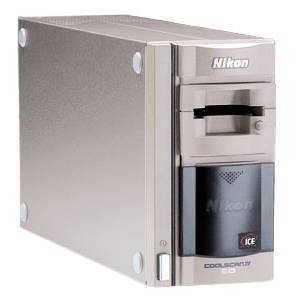 | | General |
|---|
| Model Number: | LS40 ED | | Retail Price: | $895 | | Date Available: | March 2001 | | Reading System / Optics |
|---|
| Film Type: | 35mm / Advanced Photo System Film (IX240), Slide glass for microscope (positive, negative, color or monochrome) | | Reading Resolution: | 2870 pixel monochrome linear CCD
2900 dpi optical resolution | | Film adapter: | - Slide Mount Adapter MA-20(S)
- Strip Film Adapter SA-21 (2 to 6 frames)
- Strip Film Holder FH-3 (1 to 6 frames)
- IX-240 Film Adapter IA-20(S) (15, 25, 40 frames, optional)
- Medical Slide Holder FH-G1 (for slide glass, optional)
| | Scanning area: | 25.1 x 38mm (2,870 x 4,332 pixels) | | Effective scanning area: | - SA-21: 23.3 x 36.0mm (2,657 x 4,104 pixels)
- MA-20(S): 25.1 x 36.8mm (2,870 x 4,203 pixels)
- FH-3: 24.0 x 36.0mm (2,736 x 4,104 pixels)
- IA-20(S): 16.1 x 26.9mm (1,836 x 3,067 pixels)
- FH-G1: 22.9 x 35.0mm (2,610 x 3,989 pixels)
Actual effective size depends on slide mount aperture size | | Illumination method: | R, G, B and D-LED Array | | Color Separation: | RGB line sequential | | Imaging Optics: | Scanner Nikkor ED glass lens (7 elements in 4 groups including 3 ED glass elements) | | Focusing: | Autofocus and Manual Focus | | Scanning / Signal Processing |
|---|
| Scan Time: | Approx. 42 seconds at 2900 dpi (35mm), 8-bit output (typical scan time with display, Windows, CMS off) | | Optical Density: | 3.6 dynamic range | | Thumbnail Scanning and Batch Scanning: | 35mm (135) strip film: 2 to 6 frames
IX240 film cartridge: 15, 25, 40 frames | | A/D Conversion: | 12-bits | | Output Data: | 16-bits, 8-bits per color channel (user selectable) | | Digital ICE3: | Digital ICE - automatic removal of surface defects
Digital ROC - Automatic restoration of lost color values and exposure correction
Digital GEM - Automatic removal of film grain in scanned images | | Color Management System: | Built-in; uses standard ICC profiles to color match across input devices. Apple ColorSync and Microsoft ICM compatible | | Data Transfer |
|---|
| Panel Indicators: | READY, BUSY and ERROR status indicated by front LED | | Scanning Software: | Nikon Scan 3.0 | | Interface: | USB 1.1 | | Firmware: | User downloadable from www.nikontechusa.com | | Platforms |
|---|
| Operating Systems: | MacOS 8.6 or later, Windows 98 Second Edition, Windows Me and Windows 2000 | | Operating Conditions |
|---|
| Power Requirements: | 100-240VAC, 0.3-0.2A, 50/60Hz | | Environmental: | Temperature: 50-95 °F (10-35 °C)
Relative Humidity: 20-60% (non-condensing) | | Dimensions (WxHxD): | 3.7 x 6.6 x 12.4 in. (93 x 169 x 315mm) | | Weight (approx.): | 6.6 lbs (3kg) | | Product Number |
|---|
| 9236 | Includes USB cable, Altamira Genuine Fractals 2.0 FULL version, Adobe Photoshop 5.0 LE, Nikon Scan 3.0 Driver software, Slide Mount Adapter MA-20(S), Strip Film Adapter SA-21, Strip Film Holder FH-3, AC Power cord, software and user manual. |
| Nikon Super Coolscan 4000 ED |
|---|
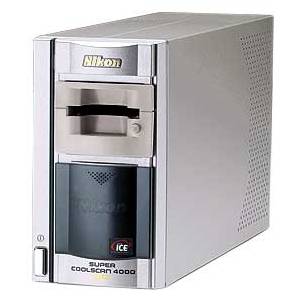 | | General |
|---|
| Model Number: | LS4000 ED | | Retail Price: | $1695 | | Date Available: | March 2001 | | Reading System / Optics |
|---|
| Film Type: | 35mm / Advanced Photo System Film (IX240), Slide glass for microscope (positive, negative, color or monochrome) | | Reading Resolution: | 3946 pixel monochrome linear CCD
4000 dpi optical resolution | | Film adapter: | - Slide Mount Adapter MA-20(S)
- Strip Film Adapter SA-21 (2 to 6 frames)
- Strip Film Holder FH-3 (1 to 6 frames)
- IX-240 Film Adapter IA-20(S) (15, 25, 40 frames, optional)
- Roll Film Adapter SA-30 (2 to 40 frames, optional)
- Slide Feeder SF-200(S) (1 to 50 frames, optional)
- Medical Slide Holder FH-G1 (for slide glass, optional)
| | Scanning area: | 25.1 x 38mm (3,946 x 5,959 pixels) | | Effective scanning area: | - SA-21: 23.3 x 36.0mm (3,654 x 5,646 pixels)
- MA-20(S): 25.1 x 36.8mm (3,946 x 5,782 pixels)
- FH-3: 24.0 x 36.0mm (3,762 x 5,646 pixels)
- IA-20(S): 16.1 x 26.9mm (2,525 x 4,219 pixels)
- SA-30: 23.3 x 36.0mm (3,654 x 5,646 pixels)
- SF-200: 25.1 x 36.8mm (3,946 x 5,782 pixels)
- FH-G1: 22.9 x 35.0mm (3,591 x 5,488 pixels)
Actual effective size depends on slide mount aperture size | | Illumination method: | R, G, B and D-LED Array | | Color Separation: | RGB line sequential | | Imaging Optics: | Scanner Nikkor ED glass lens (7 elements in 4 groups including 3 ED glass elements) | | Focusing: | Autofocus and Manual Focus | | Scanning / Signal Processing |
|---|
| Scan Time: | Approx. 38 seconds at 4000 dpi (35mm), 16-bit output (typical scan time with display, Windows, CMS off) | | Optical Density: | 4.2 dynamic range | | Thumbnail Scanning and Batch Scanning: | 35mm (135) strip film: 2 to 6 frames
IX240 film cartridge: 15, 25, 40 frames
35mm (135) strip film (with SA-30): 2 to 40 frames
35mm (135) mount film (with SF-200(S)): 1 to 50 frames | | A/D Conversion: | 14-bits | | Output Data: | 16-bits, 8-bits per color channel (user selectable) | | Digital ICE3: | Digital ICE - automatic removal of surface defects
Digital ROC - Automatic restoration of lost color values and exposure correction
Digital GEM - Automatic removal of film grain in scanned images | | Multi-sample scanning: | 2, 4, 8, 16 times (user selectable) for reduced noise | | Color Management System: | Built-in; uses standard ICC profiles to color match across input devices. Apple ColorSync and Microsoft ICM compatible | | Data Transfer |
|---|
| Panel Indicators: | READY, BUSY and ERROR status indicated by front LED | | Scanning Software: | Nikon Scan 3.0 | | Interface: | IEEE 1394 (OHCI compliant) | | Firmware: | User downloadable from www.nikontechusa.com | | Platforms |
|---|
| Operating Systems: | MacOS 8.6 or later, Windows 98 Second Edition, Windows Me and Windows 2000 | | Operating Conditions |
|---|
| Power Requirements: | 100-240VAC, 0.3-0.2A, 50/60Hz | | Environmental: | Temperature: 50-95 °F (10-35 °C)
Relative Humidity: 20-60% (non-condensing) | | Dimensions (WxHxD): | 3.7 x 6.6 x 12.4 in. (93 x 169 x 315mm) | | Weight (approx.): | 6.6 lbs (3kg) | | Product Number |
|---|
| 9282 | Includes IEEE 1394 cable (6 pin, 6 pin), IEEE 1394 Interface card (works with Windows and Macintosh G3 or later computers), Altamira Genuine Fractals 2.0 FULL version, Nikon Scan 3.0 Driver software, Slide Mount Adapter MA-20(S), Strip Film Adapter SA-21, Strip Film Holder FH-3, AC Power cord, software manual, and user manual. |
| Nikon Super Coolscan 8000 ED |
|---|
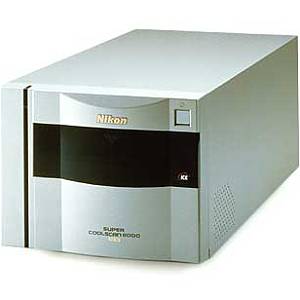 | | General |
|---|
| Model Number: | LS8000 ED | | Retail Price: | $2995 | | Date Available: | April 2001 | | Reading System / Optics |
|---|
| Film Type: | Medium Format (120/220), 35mm (135), 35mm panorama, 16mm, Electron Microscope, Slide glass for microscope | | Reading Resolution: | 4000 dpi optical resolution | | Film adapter: | - 35mm STRIP FILM HOLDER FH-835S
- 35mm MOUNTED FILM HOLDER FH-835M
- 120/220 STRIP FILM HOLDER FH-869S
- 120/220 MOUNTED FILM HOLDER FH-869M (optional)
- 120/220 STRIP FILM HOLDER WITH GLASS FH-869G (optional)
- 120/220 FILM ROTATED HOLDER WITH GLASS FH-869GR (optional)
- 16mm FILM HOLDER FH-816 (optional)
- MEDICAL SLIDE HOLDER FH-8G1 (optional)
| | Scanning area: | 63.5 x 88mm (10,000 x 13,860 pixels) | | Effective scanning area: | - FH-835S: 37.5 x 25.6mm (5,905 x 4,032 pixels)
- FH-835M: 25.4 x 37.5mm (4,000 x 5,904 pixels)
- FH-869S/FH-869G:
- 6 x 4.5: 56.9 x 42.5mm (8,964 x 6,696 pixels)
- 6 x 6: 56.9 x 56.9mm (8,964 x 8,964 pixels)
- 6 x 7: 56.9 x 70.0mm (8,964 x 11,016 pixels)
- 6 x 8: 56.9 x 77.5mm (8,964 x 12,204 pixels)
- 6 x 9: 56.9 x 83.7mm (8,964 x 13,176 pixels)
- Electron Microscope: 56.9 x 83.7mm (8,964 x 13,176 pixels)
- FH-869GR:
- 6 x 4.5: 60.3 x 45.0mm (9,496 x 7,092 pixels)
- 6 x 6: 61.6 x 61.7mm (9,700 x 9,720 pixels)
- 6 x 7: 62.8 x 74.5mm (9,889 x 11,736 pixels)
- 6 x 8: 63.4 x 80.0mm (9,984 x 12,600 pixels)
- 6 x 9: 63.5 x 88.0mm (10,000 x 13,860 pixels)
- Electron Microscope: 56.9 x 83.7mm (8,964 x 13,176 pixels)
- 35mm panoramic 24 x 58: 31.0 x 61.7mm (4,876 x 9,720 pixels)
- 35mm panoramic 24 x 65: 31.6 x 68.8mm (4,972 x 10,836 pixels)
- FH-869M:
- 6 x 4.5, 6 x 6:56.9 x 56.9mm (8,964 x 8,964 pixels)
- 6 x 6, 6 x 7, 6 x 9: 56.9 x 83.7mm (8,964 x 13,176 pixels)
- FH-816: 15.0 x 21.5mm (2,362 x 3,384)
- FH-8G1:46.0 x 24.0mm (7,248 x 3,780)
| | Illumination method: | R, G, B and D-LED Array | | Imaging Optics: | Scanner Nikkor ED glass lens (14 elements in 6 groups including 6 ED glass elements) | | Focusing: | Autofocus and Manual Focus | | Scanning / Signal Processing |
|---|
| Density Range: | 4.2D | | Thumbnail Scanning and Batch Scanning: | 35mm strip film: 1 to 12 frames (2 strips)
35mm mount film: 1 to 5 frames
120/220 strip film (6 x 4.5 size): 1 to 4 frames
120/220 mount film: 1 to 2 frames
16mm film: 1 to 60 frames (3 strips) | | A/D Conversion: | 14-bits | | Output Data: | 16-bits, 8-bits per color channel (user selectable) | | Digital ICE3: | Digital ICE, Digital ROC, Digital GEM | | Multi-sample scanning: | 2, 4, 8, 16 times (user selectable) for reduced noise | | Color Management System: | Built-in | | Data Transfer |
|---|
| Interface: | IEEE 1394 | | Operating Conditions |
|---|
| Power Requirements: | 100-240VAC, 0.3-0.2A, 50/60Hz | | Environmental: | Temperature: 10-35 °C (50-95 °F)
Relative Humidity: 20-60% RH (non-condensing) | | Dimensions (WxHxD): | 245 x 200 x 485mm (9.6 x 7.9 x 19.1 in.) | | Weight (approx.): | 9kg (19.8lbs) | | Others |
|---|
| Accessories included | 35mm STRIP FILM HOLDER FH-835S, 35mm MOUNTED FILM HOLDER FH-835M, 120/220 STRIP FILM HOLDER FH-869S, IEEE 1394 board, IEEE 1394 cable (6 pin-6 pin), Nikon Scan 3 Driver Software, AC power cord, Manual |
Updated 01-09-01 16:57ET:Full specs and product photos of all three scanners have now been added. More product photos to come as we get them!

Monday, January 8, 2001
SMaL announces CMOS sensor, tiny new digicam!
By Michael Tomkins, The Imaging Resource
(Monday, January 8, 2001 - 19:26 EST)
 SMaL Camera Technologies Inc. has introduced several new products at the International Consumer Electronics Show 2001 in Las Vegas, Nevada this week, including its SCT-OOVC CMOS imager and Ultra-Pocket credit-card digital camera. SMaL Camera Technologies Inc. has introduced several new products at the International Consumer Electronics Show 2001 in Las Vegas, Nevada this week, including its SCT-OOVC CMOS imager and Ultra-Pocket credit-card digital camera.
SMaL describes the SCT-OOVC CMOS sensor, which is used in the Ultra-Pocket camera, as "a high quality, low cost, single-chip CMOS image sensor that features ... Autobrite technology [which] allows the imager to adjust its dynamic range to provide quality images of scenes that are bright enough to saturate other standard imagers"."Most CMOS imagers also boast low cost and a compact size, but SMaL's SCT-OOVC CMOS imager goes much further," said Charles G. Sodini, Ph.D., President, SMaL Camera Technologies. "Our unique imager is based on SMaL's proprietary brightness adaptive pixel. Coupled with our proprietary algorithms, the imager allows us to design cameras that adapt to a wide variety of lighting conditions. Simply put, this Autobrite technology lets you see what you want to see - by capturing the dark details of a scene while ensuring that the bright regions never saturate. In addition to this clear advantage, our VGA imager also has the industry's lowest power consumption (33mW at 60f/s)."
Harry S. Lee, Ph.D., Vice President, Technology, SMaL Camera Technologies, added, "Coupled with our imager design is an optics design that allows us to build an extremely thin camera. For example, we are featuring our CMOS imager in a 0.2" thin digital still camera, which we call the Ultra-Pocket camera. The amazingly compact size of this camera demonstrates how easily the technology could be re-packaged in PDAs, cellular phones, PC cameras, security systems, video cameras, toys, and other applications. Manufacturers of such products have been delighted to discover that the SCT-OOVC ensures them image quality at a low cost, without sacrificing the size and battery power requirements of their products." The SCT-OOVC's VGA imager is a 642 x 482 pixel array in a 1/3" format. It offers low fixed-pattern noise and a variable frame rate up to 60 frames per second for capturing still or full-motion video. The SCT-OOVC, available in color or monochrome, also features on-chip programmable digital gain, correlated double sampling, timing, and 12-bit analog-to-digital converters.
The Ultra-Pocket is designed as an entry-level digital camera for individuals and families who desire a pocketable, affordable digital camera"When people see and use the Ultra-Pocket, it is common for them to react with a 'Wow!' at least twice," said Keith Fife, Vice President, Engineering, SMaL Camera Technologies. "The first 'wow' is a reaction to the camera's ultra-thin size - literally the size of a credit card and only 0.2" (6 mm) thin. The second occurs when they see how the Autobrite technology clearly captures the dark details of a scene while ensuring that the bright regions never saturate." The Ultra-Pocket features a sleek credit-card sized silver contour. Its VGA resolution (300,000+ pixels) is suitable for sending images via e-mail or for posting on the web. The included 8 MB MultiMediaCard removable memory can hold up to approximately 40 images. USB connectivity offers fast downloading and connectivity with Windows. SMaL notes that the camera fits easily in your pocket, goes virtually everywhere you go, and offers simple point-and-click use.
| Specification Highlights - full specifications here | | SMaL Ultra-Pocket | 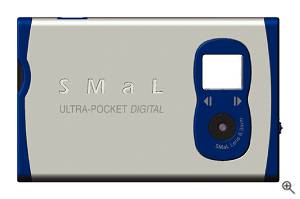 | | General | | Model Number: | Ultra-Pocket | | Camera Format: | Ultra Compact | | Retail Price: | Unknown | | Date Available: | Unknown | | Image Capture | | Image Sensor: | 0.33" 0.31 megapixel RGBG CMOS | | Image Resolution: | 640x480 | | Lens | | Focal Length (effective): | 35mm fixed focal length | | Digital Zoom: | No | | Auto Focus: | No (Fixed Focus) | | Normal Focus Range: | 91 cm to Infinity
37.3 in to Infinity | | Aperture Range: | f/2.0 (fixed aperture) | | Display | | Optical Viewfinder: | Yes (Real Image) | | LCD Viewfinder: | No | | Exposure | | Shutter Speeds: | 1/10 - 1/1000 second | | Exposure Modes: | Auto | | Flash | | Internal Flash: | No | | Ext Flash: | No | | Image Storage | | Flash Memory: | MultiMediaCard | | Memory Included (MB): | 8 | | More Information | | Weight: | 63 g
2.2 oz | | Weight With Batteries? | Yes | | Size: | 86 x 54 x 6 mm
3.4 x 2.1 x 0.2 in | | Other images | 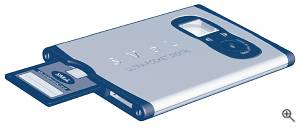 |
SMaL's Ultra-Pocket camera was selected by TechTV as a 'Best of CES' winner in the category of 'Digital Imaging'. SMaL received the award Sunday evening in a ceremony at the Las Vegas Convention Center... The Ultra-Pocket beat two other digital imaging finalists to the award, Ceiva's Internet Connected Digital Picture Frame LF2001 and Digitech Products' LLC Digiviewer digital binoculars with LCD display.
Source: SMaL website

JVC announces 2 new 3-megapixel digicams!
By Michael Tomkins, The Imaging Resource
(Monday, January 8, 2001 - 16:08 EST)
 Adding to the recent flood of new digital camera announcements (Olympus' C-2040 Zoom and C-3040 Zoom, Toshiba's PDR-M65, Canon's PowerShot Pro90 IS, and Polaroid's PDC 2300Z and PhotoMAX MP3, all of which we've reported on over the last few days), news reaches us today of two new digital cameras from JVC. The cameras (JVC's GC-QX5HD and GC-QX3HD) bear a strong resemblance to JVC's existing GC-QX3U, with a few key changes. Adding to the recent flood of new digital camera announcements (Olympus' C-2040 Zoom and C-3040 Zoom, Toshiba's PDR-M65, Canon's PowerShot Pro90 IS, and Polaroid's PDC 2300Z and PhotoMAX MP3, all of which we've reported on over the last few days), news reaches us today of two new digital cameras from JVC. The cameras (JVC's GC-QX5HD and GC-QX3HD) bear a strong resemblance to JVC's existing GC-QX3U, with a few key changes.
The GC-QX3HD looks to be a cut-down version of the QC-QX3U, with the former camera's DR-Pro Still, 6-Mega Pro Still and Multiple Layer Collage modes removed, and a silver instead of champagne-colored chassis. The camera's MSRP is listed as $1099, and its street price as $899. The GC-QX5HD looks to be an American version of the Japanese PIXSTAR GC-X3 model, which was announced in September of last year. It retains all of the features of the GC-QX3U, although the 6-Mega Pro Still mode is renamed the 6 Megapixel Film Copy mode, and a film copy attachment is added to the camera bundle. The camera isn't black, like the Pixstar, however - it gets a dark grey chassis instead.
Another change in both cameras is the addition of a 1080i HDTV output (1080 scanning line interlaced), as well as the existing NTSC video output. Finally, the last change we can see is in the bundled SmartMedia card size - where the GC-QX3U had an 8MB SmartMedia card, it seems that one of the new cameras (we're guessing the GC-QX5HD) will come with a 16MB SmartMedia card. Unfortunately, JVC's press release and website contradict each other on which of the new cameras comes with 8MB, and which with 16MB. ;)
| Specification Highlights - full specifications here | | JVC GC-QX5HD | 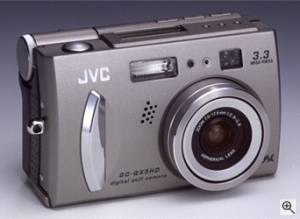 | | General | | Model Number: | GC-QX5HD | | Camera Format: | Compact | | Retail Price: | $1299 | | Date Available: | 2001-01-08 | | Image Capture | | Image Sensor: | 0.55" 3.34 megapixel RGBG CCD | | Image Resolution: | 2032x1536, 1024x768, 640x480 | | Movie Resolution: | 160x120 | | Lens | | Focal Length (effective): | 37 - 86 mm (2.3x optical zoom) | | Digital Zoom: | Yes (Up to 3.1x) | | Auto Focus: | Yes | | Manual Focus: | Yes | | Normal Focus Range: | Unknown | | Macro Focus Range: | Unknown | | Aperture Range: | f/2.8 - f/11 | | Display | | Optical Viewfinder: | Yes (Real Image type) | | LCD Viewfinder: | Yes (2.0 inch, 200000 pixel) | | Exposure | | ISO Settings: | 80, 160, 320 | | White Balance Settings: | Unknown | | Manual White Balance: | Yes | | Shutter Speeds: | 1/4 - 1/750 second | | Exp Adj Range: | +/- 2.0 EV in 0.5 EV steps | | Metering Modes: | Multi, Spot | | Exposure Modes: | Auto, Aperture Priority, Manual | | Self Timer (seconds): | 1 or 8 sec | | Flash | | Internal Flash: | Yes | | Flash Modes: | Auto, Red-eye reduction, Off | | Flash Range Description: | Up to 2.5 meters | | Ext Flash: | No | | Image Storage | | Flash Memory: | SmartMedia | | Memory Included (MB): | 8 | | File Formats: | TIFF, JPEG, JVC Proprietary Video | | More Information | | Remote Control: | No | | Tripod Mount: | Yes (Plastic) | | Weight: | 290 g
10.1 oz | | Weight With Batteries? | No | | Size: | 101 x 67 x 59 mm
4.0 x 2.6 x 2.3 in | | Notes & Features: | Similar to GC-QX3HD (below) but adds a Film Copy Attachment to the bundle, as well as the following changes: DR Pro-Still mode takes two pictures, one bright and one dark, and merges the two, creating a final image claimed to have triple the dynamic range. 6 Megapixel Film Copy mode uses a movement of the optical refraction plate to shift the image 3.45 microns (1 pixel) upwards in between shots. Using this method, the light falls onto colors of different pixels in each shot, allowing less of the data to require interpolation. Every green pixel is recorded, not interpolated, whilst the red and blue data is doubled. A 3.34 megapixel 2032 x 1536 image which JVC notes offers color reproduction equivalent to over 6 megapixels is the result. Multiple Layer Collage mode allows a 'lumakey' type effect where a subject on a light background can be overlaid on another image in-camera. |
| Specification Highlights - full specifications here | | JVC GC-QX3HD | 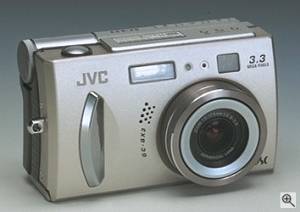 | | General | | Model Number: | GC-QX3HD | | Camera Format: | Compact | | Retail Price: | $1099 | | Date Available: | 2001-01-08 | | Image Capture | | Image Sensor: | 0.55" 3.34 megapixel RGBG CCD | | Image Resolution: | 2032x1536, 1024x768, 640x480 | | Movie Resolution: | 160x120 | | Lens | | Focal Length (effective): | 37 - 86 mm (2.3x optical zoom) | | Digital Zoom: | Yes (Up to 3.1x) | | Auto Focus: | Yes | | Manual Focus: | Yes | | Normal Focus Range: | Unknown | | Macro Focus Range: | Unknown | | Aperture Range: | f/2.8 - f/11 | | Display | | Optical Viewfinder: | Yes (Real Image type) | | LCD Viewfinder: | Yes (2.0 inch, 200000 pixel) | | Exposure | | ISO Settings: | 80, 160, 320 | | White Balance Settings: | Unknown | | Manual White Balance: | Yes | | Shutter Speeds: | 1/4 - 1/750 second | | Exp Adj Range: | +/- 2.0 EV in 0.5 EV steps | | Metering Modes: | Multi, Spot | | Exposure Modes: | Auto, Aperture Priority, Manual | | Self Timer (seconds): | 1 or 8 sec | | Flash | | Internal Flash: | Yes | | Flash Modes: | Auto, Red-eye reduction, Off | | Flash Range Description: | Up to 2.5 meters | | Ext Flash: | No | | Image Storage | | Flash Memory: | SmartMedia | | Memory Included (MB): | 8 | | File Formats: | TIFF, JPEG, JVC Proprietary Video | | More Information | | Remote Control: | No | | Tripod Mount: | Yes (Plastic) | | Weight: | 290 g
10.1 oz | | Weight With Batteries? | No | | Size: | 101 x 67 x 59 mm
4.0 x 2.6 x 2.3 in | | Notes & Features: | Bundled with Rechargeable Battery, AC Adapter/Battery Charger, 8MB SmartMedia Card, Hand Strap, USB Cable, CD-ROM, HDTV Output Cable and Video Cable. Has a 1080i HDTV output (1080 scanning line interlaced). NR Pro-Still (Noise Reduction) mode takes multiple exposures and uses the data to reduce random noise (JVC claims a 9db rduction). DCF and DPOF compliant. Black and White*, Sepia*, and Negi-Posi modes (picture is converted in playback). Cold-forged aluminum chassis with carbon-fiber reinforced polymer back. Video clips are 200KB or less, bundled proprietary software (220KB) required for playback. Bundled charger doubles as an AC adapter. LCD display has 30 frames per second refresh. |
Source: JVC website

UMC announces low dark current noise CMOS sensor process!
By Michael Tomkins, The Imaging Resource
(Monday, January 8, 2001 - 13:42 EST)
 Semiconductor foundry UMC today announced an enhanced CMOS image sensor process, which is based on its generic mixed-mode process. The proprietary technology, says the company, "will address the needs of today's most sophisticated camera-on-a-chip designers that produce chips for high-end, still life and video digital cameras and scanners". Semiconductor foundry UMC today announced an enhanced CMOS image sensor process, which is based on its generic mixed-mode process. The proprietary technology, says the company, "will address the needs of today's most sophisticated camera-on-a-chip designers that produce chips for high-end, still life and video digital cameras and scanners".
UMC claims that its new process results in a lower than average dark current level, allowing image sensors manufactured with the process to detect light at lower light conditions. The company feels that the result is image quality that is" superior to any other foundry's CMOS technology".
UMC notes that its CMOS process is the first to demonstrate '3-in-1 integration', where the analog to digital converter, digital image processor and sensor are integrated onto a single chip. The company says that it will be accepting design-ins for its 0.18-micron CMOS sensor, which will enable pixel sizes as low as three microns and resolutions above 5 megapixels in the first quarter of 2001."Because our CMOS image sensor solution offers high quality and resolution and is cost effective, it clearly addresses the requirements of chip developers for the digital camera market," said Jim Ballingall, vice president of worldwide marketing at UMC. "Our solution is clearly unparalleled in the foundry space in its comparability to CCD, the key being exceptionally low dark current levels -as low as 65 pA/cm2 -which allow for high image quality regardless of light conditions. The transition from CCD to UMC's CMOS sensor process is further facilitated by the fact that changes in optics are not necessary due to the small pixel sizes that are enabled by the process. Particularly exciting is the fact that this complements our offerings in advanced logic, mixed-signal, and micro-display technologies so that customers can access UMC for a complete digital camera solution."
Sabrina Kemeny, CEO at Photobit Corporation said, "As a leading supplier of CMOS image sensors, we must keep up with the market's high demand for video imaging products by delivering the most leading-edge camera system on a chip. UMC's CMOS sensor process has by far exceeded our expectations for quantum efficiency and sensitivity. We look forward to continuing our long-term relationship with UMC as they continue to deliver the highly-reliable, excellent quality image sensor process technology we need for development of our camera-on-a-chip."
Dr. Derek Cheung, Rockwell's vice president of research and director of the Rockwell Science Center said, "We committed to UMC's 0.25-micron CMOS image sensor process technology for developing our CMOS imaging system-on-a-chip (i-SoC(TM)) for high performance video cameras, because it enables us to offer comparable resolution and image quality to incumbent CCDs with obvious cost advantages and an unprecedented set of embedded features. We look forward to migrating to UMC's 0.18-micron process soon and achieving even greater performance."
Source: Yahoo! Finance / Business Wire

Xirlink announces low-cost megapixel camera design!
By Michael Tomkins, The Imaging Resource
(Monday, January 8, 2001 - 12:03 EST)
 Taiwanese digicam manufacturer Xirlink Inc. has announced the release of its XVP-299 megapixel digital still camera platform. With the XVP-299, says Xirlink, "OEMs can for the first time allow entry-level customers to enjoy the benefits of high-resolution [megapixel] photography". Taiwanese digicam manufacturer Xirlink Inc. has announced the release of its XVP-299 megapixel digital still camera platform. With the XVP-299, says Xirlink, "OEMs can for the first time allow entry-level customers to enjoy the benefits of high-resolution [megapixel] photography".
With a price point claimed to be below that of competing megapixel digital cameras, Xirlink feels its XVP-299 will give OEMs a highly promotable, value-priced camera for the consumer market."Price-conscious digital camera consumers have been looking for an opportunity to move into megapixel cameras," said Tim Martin, Director of Marketing at Xirlink. "Our new XVP-299 platform allows our OEM partners to offer a value-priced megapixel camera with exceptional image quality and larger print capability. The XVP-299 is a fully-featured, high-quality camera with the industry's best price/performance ratio." The 1.3 megapixel XVP-299 offers a CCD sensor with 1280 x 960 image resolution. It provides external Compact Flash Type II storage and optional internal memory up to 8MB, and supports USB 1.1 connectivity as well as NTSC output.
Other noteworthy features of the XVP-299 include a fixed focus lens with macro focus mode, and a 1.8" color TFT LCD with on-screen display. It also offers automatic exposure control and white balance, a three-mode quench strobe flash (off, auto, fill), and 10-second self-timer.
Xirlink's new MP camera is currently available for OEM purchase, with first shipments expected in 2Q 2001. The XVP-299 is aimed at OEM customers and system integrators who wish to expand their low-price offerings from CIF and VGA models. Whilst pricing is claimed to be lower than competing camera designs, Xirlink doesn't disclose pricing in its press release and the XVP-299 was not listed on its US or Taiwanese websites at the time of this writing...
Source: Yahoo! Finance / Business Wire

Lexar CompactFlash wins PC Photo magazine award!
By Michael Tomkins, The Imaging Resource
(Monday, January 8, 2001 - 11:28 EST)
 Lexar Media Inc. has announced that it has won an Editor's Choice Award from PC Photo magazine for its CompactFlash Digital Film. Lexar's USB-enabled digital film products are available from retailers, camera dealers, distributors and the company's Web site in capacities ranging from 16 to 320 megabytes and in speeds ranging from 4x to 12x. Each year, the editors of PC Photo select 50 products to be awarded Editor's Choice. Lexar Media Inc. has announced that it has won an Editor's Choice Award from PC Photo magazine for its CompactFlash Digital Film. Lexar's USB-enabled digital film products are available from retailers, camera dealers, distributors and the company's Web site in capacities ranging from 16 to 320 megabytes and in speeds ranging from 4x to 12x. Each year, the editors of PC Photo select 50 products to be awarded Editor's Choice."Winning the Editor's Choice Award is extremely gratifying," said John Reimer, president and CEO of Lexar Media. "The editors at PC Photo clearly recognize the importance digital photographers place on using high speed, high capacity digital film. As a market leader, Lexar Media takes pride in providing the best products possible to help digital photographers maximize their digital photography experience."
Source: Yahoo! Finance / PR Newswire

Polaroid announces photo-sharing website!
By Michael Tomkins, The Imaging Resource
(Monday, January 8, 2001 - 10:51 EST)
 Polaroid Corp. has launched PolaroidDigital.com, a new Web site that the company says is "designed to enhance and expand the digital photography experience for consumers". Introduced at the 2001 International Consumer Electronics Show in Las Vegas, PolaroidDigital.com was created with help from ArcSoft, Inc., a Fremont, California-based provider of interactive software and Internet imaging networks. ArcSoft developed and is hosting PolaroidDigital.com through its PhotoIsland Network System. Polaroid Corp. has launched PolaroidDigital.com, a new Web site that the company says is "designed to enhance and expand the digital photography experience for consumers". Introduced at the 2001 International Consumer Electronics Show in Las Vegas, PolaroidDigital.com was created with help from ArcSoft, Inc., a Fremont, California-based provider of interactive software and Internet imaging networks. ArcSoft developed and is hosting PolaroidDigital.com through its PhotoIsland Network System."Since our customers have a broad range of imaging needs, we created PolaroidDigital.com so they can do more than just share their photos online," said Craig Armstrong, director, Worldwide Consumer Electronics, Polaroid Corporation. "The wonder of digital photography is its accessibility and innate ability to be transmitted through many channels. The Website allows our valued customers to have fun with their photographs, while educating them on how to further enhance their love of digital photography through sharing methods like digital picture frames and the Internet."
"We are quite pleased to work closely with Polaroid and to provide them with a turnkey online imaging network through our Internet Infrastructure Services," said Anna Jen, vice president of ArcSoft's Internet Services Division. "Powered by our PhotoIsland Network System, Polaroid will be able to offer a range of interactive, value-added services that builds site stickiness and loyalty with consumers." Some of the features of PolaroidDigital.com include:- Share and Send - Log in to your free Polaroid Digital Account or Polaroid Digital Picture Frame Account to view, share and send your digital photos or electronic postcards.
- Get Creative - Utilize options like messages and music to personalize your photographs. And, through an online venture with Kazoo3D, Polaroid customers can add 3D images of cartoon characters and other graphics to their digital photos.
- Member Help - Get help installing and using Polaroid digital products including cameras and the Polaroid PhotoMAX Digital Picture Frame.
- Product Registration - Sign up for a free Polaroid Digital Account and register your Polaroid Digital Picture Frame or digital camera.
- Look, Learn and Buy - Find out what's new from Polaroid! Take a look at the latest Polaroid digital products and accessories.
Source: Yahoo! Finance / PR Newswire

UPDATED: Polaroid announces two new digicams!
By Michael Tomkins, The Imaging Resource
(Monday, January 8, 2001 - 0:16 EST)
 Polaroid Corp. has unveiled several new digital-imaging products that it says "deliver on the company's vision for the future of photography and image sharing" at the 2001 International Consumer Electronics Show, currently being held January 6-9 in Las Vegas. The company's new products include the Polaroid Digital Picture Frame, MP3 Digital Camera, and 2300Z Digital Camera, as well as the P-500 Digital Photo Printer. (We first told you about these upcoming cameras in our news item of July 17, 2000, entitled "Polaroid planning its first 2 megapixel, MP3, Internet and instant print digicams!") Polaroid Corp. has unveiled several new digital-imaging products that it says "deliver on the company's vision for the future of photography and image sharing" at the 2001 International Consumer Electronics Show, currently being held January 6-9 in Las Vegas. The company's new products include the Polaroid Digital Picture Frame, MP3 Digital Camera, and 2300Z Digital Camera, as well as the P-500 Digital Photo Printer. (We first told you about these upcoming cameras in our news item of July 17, 2000, entitled "Polaroid planning its first 2 megapixel, MP3, Internet and instant print digicams!")
The press release notes that later this year Polaroid will introduce a digital modem camera, "eliminating the need for personal computers as a critical link in sharing and printing digital images".
The Polaroid Digital Picture Frame can accept pictures from Polaroid's digital cameras, or alternatively can automatically receive downloaded images from PolaroidDigital.com once a day via a phone line. (The frame also offers a selection of information from the Internet, including weather reports, winning lottery numbers and daily horoscopes.)
The P-500 photo printer is compatible with a range of digital cameras, enabling users to insert a memory card and print their digital images without the need for a computer."Polaroid's overarching vision has been to combine its rich heritage in instant imaging with the future of digital," explained Polaroid Chairman and Chief Executive Officer, Gary T. DiCamillo. "We are delivering on this goal by focusing on innovative, customer-focused products that will build Polaroid's presence in the burgeoning digital imaging market. Polaroid is answering the question about the role of film in digital imaging with the launch of the P-500, which integrates instant film with digital images."DiCamillo added, "With the Polaroid Digital Picture Frame, Polaroid has ensured that anyone may have access to images via the Internet, without needing to use a personal computer. This is a crucial step in the evolution of information exchange via the Internet." Following is a list of Polaroid's CES announcements:- P-500 Digital Photo Printer - Billed by Polaroid as "the first truly mobile photo printer". The P-500 allows photographers to print images without a computer. Compatible with CompactFlash or SmartMedia card (with included adapter), allows the user to choose an image or images to print, and push a button for full color prints in about 20 seconds. The P-500 is compatible with all Polaroid PhotoMAX digital cameras, as well as "a majority of other digital cameras currently on the market".
- PhotoMAX Digital Picture Frame - The Polaroid PhotoMAX Digital Picture Frame allows users to share their images with friends and family who do not have access to a personal computer. Photographers send their images through the Polaroid website, PolaroidDigital.com. The frame then receives digital images from the Internet and displays them in color on a 5x7-inch LCD screen. A phone line connection is needed for the picture frame.
- PhotoMAX MP3 Digital Camera - Allows users to listen to music and capture images in one device. The camera accepts MP3 music files and can take 640x480 resolution images.
- PDC 2300Z digital camera - The PDC 2300Z is Polaroid's first two-megapixel digital camera produced for the consumer market. Billed as "the most technologically advanced digital camera in the Polaroid PhotoMAX line", the camera has a 2.3 megapixel resolution and a 2.3X optical zoom lens. With a suggested list price of $399, Polaroid claims the PDC 2300Z costs less than comparable photo quality digital cameras.
- PolaroidDigital.com -- A Polaroid website that "provides practical information and fun features that help consumers facilitate sharing of digital photographs with friends and family". The site allows users to send personalized greetings, post photos to an auction site, and create a personalized online photo album accessible for selected others. Creating a Polaroid Digital account is free, and most of the site's services are free.
| Specification Highlights - full specifications here | | Polaroid PDC 2300Z |  | | General | | Model Number: | PDC 2300Z | | Camera Format: | Compact | | Retail Price: | $399 | | Date Available: | 2001-01-07 | | Image Capture | | Image Sensor: | 2.3 megapixel | | Image Resolution: | Unknown ("Six image resolution modes") | | Lens | | Focal Length (effective): | 2.3x optical zoom | | Digital Zoom: | Yes (2x) | | Auto Focus: | Yes | | Manual Focus: | Unknown | | Normal Focus Range: | 46 cm to Infinity
18.7 in to Infinity | | Macro Focus Range: | 38 - 46 cm
15.5 - 18.7 in | | Aperture Range: | f/3.02 - f/13.45 | | Display | | Optical Viewfinder: | Yes (Real Image type) | | LCD Viewfinder: | Yes (1.8 inch) | | Flash | | Internal Flash: | Yes | | Flash Modes: | red-eye reduction | | Flash Range Description: | 1.6 to 10 feet (0.49 to 3.05 m) | | Ext Flash: | No | | Image Storage | | Flash Memory: | Unknown ("removable memory card") | | Memory Included (MB): | 8 | | File Formats: | JPEG | | More Information | | Self Timer (seconds): | 10 | | Notes & Features: | Bundled with Polaroid PhotoMAX Pro Software, 4 AA Batteries, USB cable, Serial cable, AC adapter, Wrist strap and camera case, Hardware/Software, User's Guide and Software Online Help. Has six (unspecified) image resolutions. |
| Specification Highlights - full specifications here | | Polaroid PhotoMAX MP3 | 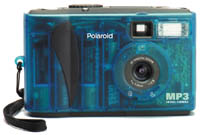 | | General | | Model Number: | PhotoMAX MP3 | | Camera Format: | Compact | | Retail Price: | Unknown | | Date Available: | Unknown | | Image Capture | | Image Sensor: | Unknown (640 x 480 file size, may be interpolated) | | Image Resolution: | 640x480, 320x200 | | Lens | | Focal Length (effective): | Fixed focal length (unspecified) | | Digital Zoom: | Unknown | | Auto Focus: | No (Fixed focus) | | Normal Focus Range: | 61 cm to Infinity
24.9 in to Infinity | | Display | | Optical Viewfinder: | Yes (Real Image type) | | LCD Viewfinder: | Yes (Size unknown) | | Flash | | Internal Flash: | Yes | | Flash Range Description: | 3 to 10 feet (0.91 to 3.05 m) | | Ext Flash: | No | | Image Storage | | Flash Memory: | CompactFlash Type-I | | Memory Included (MB): | 16 | | File Formats: | JPEG | | More Information | | Self Timer (seconds): | Yes (length unknown) | | Notes & Features: | Bundled with 16 MB CompactFlash card (stores music and photos), Earphones, 4 AA batteries, USB cable, Video cable, Wrist strap, Camera case with belt clip, Quickstart Guide, Quick reference card, Polaroid PhotoMAX Image Maker and Nullsoft Winamp MP3 player software. |
Updated 01-08-01 10:53ET: Both cameras have now been added to our digital camera database, and links have been added above each specification highlight above to the full database entry for the camera...
Source: Yahoo! Finance / PR Newswire

Saturday, January 6, 2001
UPDATED: Canon announces new SLR-style digital camera!
By Michael Tomkins, The Imaging Resource
(Saturday, January 6, 2001 - 14:25 EST)
 Japanese camera manufacturer Canon Inc. has today announced a new digital camera at the Consumer Electronics Show (CES) in Las Vegas, the PowerShot Pro90 IS. The Pro90, which combines much of the functionality of the PowerShot G1 in a body reminiscent of the previous PowerShot Pro70 model, is the first we've seen from Canon using their 10x optical zoom image stabilising lens. It also features a 3.34 megapixel CCD image sensor, but similarly to Sony's DSC-F505V, the combination of lens, chassis and image sensor results in a portion of the sensor being masked off, leaving an effective resolution of 2.58 megapixels (as compared to 3.24 megapixels on most other 3.34 megapixel cameras). The strength of that zoom lens could more than make up for this in many situations, however, allowing you to fill the picture with your subject where most other cameras couldn't... An optional wide-angle converter will extend the range of the lens from 37-370mm to 29.6mm at wide angle. Gone from the camera is the PowerShot Pro70's separate viewfinder optics - but the Pro90 IS is not a true SLR either, instead taking a route that has become popular with many manufacturers recently, the Electronic Viewfinder (essentially a mini LCD display). Japanese camera manufacturer Canon Inc. has today announced a new digital camera at the Consumer Electronics Show (CES) in Las Vegas, the PowerShot Pro90 IS. The Pro90, which combines much of the functionality of the PowerShot G1 in a body reminiscent of the previous PowerShot Pro70 model, is the first we've seen from Canon using their 10x optical zoom image stabilising lens. It also features a 3.34 megapixel CCD image sensor, but similarly to Sony's DSC-F505V, the combination of lens, chassis and image sensor results in a portion of the sensor being masked off, leaving an effective resolution of 2.58 megapixels (as compared to 3.24 megapixels on most other 3.34 megapixel cameras). The strength of that zoom lens could more than make up for this in many situations, however, allowing you to fill the picture with your subject where most other cameras couldn't... An optional wide-angle converter will extend the range of the lens from 37-370mm to 29.6mm at wide angle. Gone from the camera is the PowerShot Pro70's separate viewfinder optics - but the Pro90 IS is not a true SLR either, instead taking a route that has become popular with many manufacturers recently, the Electronic Viewfinder (essentially a mini LCD display).
Canon has posted full details of the camera on its BeBit website, along with two sample images. Our friends over at the Digital Photography Review meanwhile have posted an in-depth review of the camera along with numerous closeups of the control layout, and sample images. Here's some of their conclusion:"The Pro90 is a very different beast [from the Pro70], we could have guessed ahead of time that it would have the 10x zoom lens announced earlier by Canon, the 2.6 megapixel resolution will probably be a surprise to many but in our real life use it made little difference day-to-day. Feature wise the Pro90 is as rich as the G1 on which its based, and we all know how popular the G1 has become. There are certainly gripes and things which need to be put right, but as a whole the Pro90 currently stands alone as the digital camera with the combination of a long zoom lens and 2.6 megapixels of resolution.
Anyone considering a 3 megapixel digital camera should seriously consider the Pro90, forget bolting aftermarket 3x lenses onto that fragile lens thread, this camera has everything you need in one package, that plus great image quality. Anyone considering the Sony DSC-F505V or Olympus C-2100UZ must now consider the excellent Canon Pro 90 IS. Kudos once more for Canon." Be sure to check out Phil's full review of the camera, and the specifications in our digital camera database!
| Specification Highlights - full specifications here | | Canon PowerShot Pro90 IS | 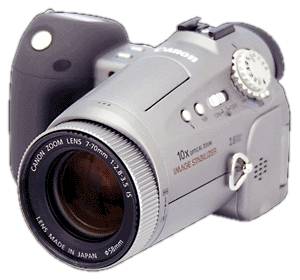 | | General | | Model Number: | Pro90 | | Camera Format: | SLR | | Retail Price: | Unknown | | Date Available: | Unknown | | Image Capture | | Image Sensor: | 0.55" 3.34 megapixel RGBG CCD (2.58 megapixel effective) | | Image Resolution: | 1856x1392, 1024x768, 640x480 | | Lens | | Focal Length (effective): | 37 - 370 mm (10x optical zoom) | | Digital Zoom: | 2x, 4x | | Auto Focus: | Yes | | Manual Focus: | Yes | | Normal Focus Range: | 10 cm to Infinity
4.1 in to Infinity | | Macro Focus Range: | 10cm - 10 cm
4.2 - 4.2 in | | Aperture Range: | f/2.8 - f/8 | | Display | | Optical Viewfinder: | Yes (Eye level LCD) | | LCD Viewfinder: | Yes (1.8 inch) | | Exposure | | ISO Settings: | 50, 100, 200, 400 | | White Balance Settings: | Auto, Daylight, Cloudy, Tungsten, Fluorescent, Flash, Hold | | Manual White Balance: | Yes | | Shutter Speeds: | 8 - 1/1000 second | | Exp Adj Range: | +/- 2.0EV in 0.333EV steps | | Metering Modes: | Center-weighted average metering, Spot metering | | Exposure Modes: | Auto, Aperture Priority, Shutter Priority, Manual | | Self Timer (seconds): | 10 | | Flash | | Internal Flash: | Yes | | Flash Modes: | Auto, Red-eye reduction auto, Red-eye reduction On, On or Off | | Flash Range Description: | 70 cm - 4.2 m (2.3 ft. - 13.8 ft.) wide, 1 m - 3.4 m (3.3 ft. - 11.2 ft.) tele at ISO100 | | Ext Flash: | Yes (Accessory shoe with sync terminals, intelligent with Speedlite 220EX, 380EX, 420EX and 550EX) | | Image Storage | | Flash Memory: | CompactFlash Type-I, CompactFlash Type II, MicroDrive | | Memory Included (MB): | 16 | | File Formats: | CCD-RAW, JPEG, AVI (QuickTime MotionJPEG) | | More Information | | Remote Control: | Yes (IR) | | Tripod Mount: | Yes (Metal) | | Weight: | 680 g
23.8 oz | | Weight With Batteries? | No | | Size: | 127 x 84 x 139 mm
5.0 x 3.3 x 5.5 in | | Notes & Features: | Image sensor is 3.34 megapixel but masking due to lens/chassis/sensor combination limits effective sensor resolution to 2.58 megapixel. Lens has image stabilisation. Lens iris is used as mechanical shutter, meaning 1/1000 second shutter speed can only be used at F4 to F8. Auto ISO selects from either ISO 50 or ISO 100. Flash exposure compensation (+/- 2.0EV in 1/3EV steps) is possible. 'Creativity' modes are Pan-focus, Portrait, Landscape, Night scene, Black & white, Stitch Assist and Movie. Serial connectivity requires optional serial cable. DCF and DPOF compliant. Can record audio (monaural) as a wave file. |
Updated 01-08-01 11:30ET: Link to Canon's press release at Yahoo! Finance added.
Source: Yahoo! Finance / BusinessWire

Friday, January 5, 2001
Sony demonstrates InfoStick Bluetooth module!
By Michael Tomkins, The Imaging Resource
(Friday, January 5, 2001 - 17:53 EST)
 The Japanese PC Watch website has posted a news item in Japanese detailing a new working prototype product from electronics giant Sony Corp. Sony's new InfoStick Bluetooth module will be demonstrated at the CES Show in Las Vegas tomorrow. The module, which has the same form factor and pinouts as Sony's MemoryStick flash cards, adds Bluetooth wireless networking to products such as digital cameras, PDA's, and the suchlike. It won't be backwardly compatible with existing MemoryStick products though, the product must support the module. The Japanese PC Watch website has posted a news item in Japanese detailing a new working prototype product from electronics giant Sony Corp. Sony's new InfoStick Bluetooth module will be demonstrated at the CES Show in Las Vegas tomorrow. The module, which has the same form factor and pinouts as Sony's MemoryStick flash cards, adds Bluetooth wireless networking to products such as digital cameras, PDA's, and the suchlike. It won't be backwardly compatible with existing MemoryStick products though, the product must support the module.
The InfoStick Bluetooth module is based on a newly developed all-in-one LSI (Large Scale Integration) chip for the Bluetooth baseband signal, MemoryStick interface and memory controller. This chip is mounted along with the RF module, flash memory, antenna and EEPROM to create the 21.5 x 55 x 2.8mm, 4 gram InfoStick. The stick has a range of 10 meters and a transfer rate of 1Mbps in line with the Bluetooth specification...
Sony apparently created the InfoStick Bluetooth module as part of its research and development into the possibilities of adding Internet access and networking to its products. Sony has previously shown InfoStick mockups and prototypes of a camera module, GPS module and Fingerprint Reader module. As for whether the Bluetooth module will ever see the light of day as a product, Sony's page notes that the module "is likely to differ from the specifications of any commercial product because it is a prototype" - so who knows, it could just happen! ;)
Source: PC Watch website

UPDATED: Toshiba announces PDR-M65 digital camera!
By Michael Tomkins, The Imaging Resource
(Friday, January 5, 2001 - 15:22 EST)
 Toshiba will tomorrow announce its new PDR-M65 3.3 Megapixel digital still camera which it says "provides consumers, photography enthusiasts and business users with a compact, high-quality, low-cost camera that incorporates state-of-the-art imaging performance with exceptional ease-of-use". (Our friends over at Steve's Digicams have posted the news today, so we're posting it as well now that the information is already publicly available...) Toshiba will tomorrow announce its new PDR-M65 3.3 Megapixel digital still camera which it says "provides consumers, photography enthusiasts and business users with a compact, high-quality, low-cost camera that incorporates state-of-the-art imaging performance with exceptional ease-of-use". (Our friends over at Steve's Digicams have posted the news today, so we're posting it as well now that the information is already publicly available...)
The PDR-M65 is expected to ship in February 2001 with an aggressive MSRP of $599, and both Microsoft Windows� (98/2000/ME) and Apple Macintosh� platforms are supported. The camera features USB connectivity, a five-mode automatic flash system, and is claimed to use "advanced circuitry for quicker booting and less processing time between shots". The camera is based on a 3.3 megapixel, 1/2-inch CCD that offers resolutions up to 2048 x 1536 pixels in JPEG format.
The camera also sports an all-glass 38-114mm (35mm equivalent) 3x optical zoom lens, and a digital 2X playback zoom. The camera features a user-selectable Macro Mode for close-ups up to 3.9 inches. In normal focusing mode, the camera range is 3.9 inches to infinity. A dioptric corrector is included to focus the viewfinder to the user's eyesight. With the use of an optional filter/lens ring adapter, commercially available 52mm optical filters or lens can be used.
The PDR-M65, says Toshiba, "was designed for individuals who want high quality digital images for business or personal use -- but who do not want the hassle of overcoming a new technology learning curve. For that reason, Toshiba based the camera design on standard 'point-and-shoot' film cameras". To operate the PDR-M65, there is a top-mounted Mode Dial that lets the photographer hold the camera and select settings using only their thumb. Manual, auto, playback, PC (for downloading), and set-up modes are accessed from the dial. Settings are shown and selected from the camera's 1.8-inch color LCD display.
To frame pictures, the PDR-M65 is equipped with both the LCD and optical viewfinder. The camera�s five-mode flash system (automatic, red-eye reduction, forced-fill flash, slow synchro and force-off) works up to 13-feet (4 meters) from the subject. The PDR-M65 includes three levels of compression: fine, normal, and basic.
The press release proudly notes that "[breakneck] downloading speed is a tradition for Toshiba cameras, and the PDR-M65 is no exception. Thanks to an exclusive software driver and USB technology, the PDR-M65 downloads even the largest images in less than a second". For viewing your pictures on a TV, the PDR-M65 has a video out connector, enabling several people to view images concurrently, plus enabling the user to transfer images to video tape.
The PDR-M65 uses SmartMedia memory cards in 8, 16, 32 and 64MB sizes, and is powered by 4 AA batteries. The camera weighs 10.2 ounces, measures 4.76(W) x 2.95(H) x 2.4(D) inches, and will be available in February 2001 at a suggested MSRP of $599. It comes bundled with multi-platform CD software from Sierra Imaging for accessing, managing and enhancing digital photos. Also included are a USB cable, video-out cable, neck strap, and an 8MB SmartMedia Card.
| Specification Highlights - full specifications here | | Toshiba PDR-M65 | 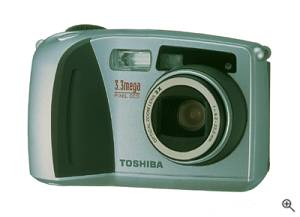 | | General | | Model Number: | PDR-M65 | | Camera Format: | Compact | | Retail Price: | $599 | | Date Available: | 2001-02-28 | | Image Capture | | Image Sensor: | 0.5" 3.34 megapixel RGBG CCD | | Image Resolution: | 2048x1536, 1024x768 | | Lens | | Focal Length (effective): | 38 - 114 mm (3x optical zoom) | | Digital Zoom: | Unknown (2x playback zoom) | | Auto Focus: | Yes | | Manual Focus: | Unknown | | Normal Focus Range: | 10 cm to Infinity
4.0 in to Infinity | | Macro Focus Range: | 10cm - 10 cm
4.2 - 4.2 in | | Aperture Range: | Unknown | | Display | | Optical Viewfinder: | Yes (Real Image type) | | LCD Viewfinder: | Yes (1.8 inch) | | Flash | | Internal Flash: | Yes | | Flash Modes: | Automatic, red-eye reduction, forced-fill flash, slow synchro, force-off | | Flash Range Description: | Up to 13 feet (4 meters) | | Ext Flash: | No | | Image Storage | | Flash Memory: | SmartMedia | | Memory Included (MB): | 8 | | File Formats: | JPEG | | More Information | | Remote Control: | Unknown | | Tripod Mount: | Unknown | | Weight: | 289 g
10.1 oz | | Weight With Batteries? | No | | Size: | 121 x 75 x 61 mm
4.8 x 2.9 x 2.4 in | | Notes & Features: | Compatible with SmartMedia up to 64MB. Has a diopter correction on the optical viewfinder. Bundled with 8MB SmartMedia card, USB cable, video-out cable, and neck strap. |
Updated 01/05-01 15:40: The PDR-M65 has now been added to the camera database!

digitalkamera.de posts 128MB SmartMedia report!
By Michael Tomkins, The Imaging Resource
(Friday, January 5, 2001 - 14:07 EST)
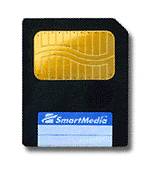 Our friends at the German website, digitalkamera.de, have posted an extremely interesting article for owners of SmartMedia-based digital cameras. The site managed to obtain a functioning sample of a 128MB SmartMedia card, and tested it with a number of digital cameras to see if they would accept it without problems. Our friends at the German website, digitalkamera.de, have posted an extremely interesting article for owners of SmartMedia-based digital cameras. The site managed to obtain a functioning sample of a 128MB SmartMedia card, and tested it with a number of digital cameras to see if they would accept it without problems.
Of the 19 cameras digitalkamera.de tested, 17 worked fine with the cards. Two cameras, Toshiba's PDR-M60 and PDR-M70 will work after an upgrade, according to the company... A further seven cameras will, according to their manufacturers, work fine as is.
So what didn't work? Well, of the cameras tested in the article, only two didn't like 128MB SmartMedia, Ricoh's RDC-5300 and RDC-6000. Two other cameras were listed by the site as working with 64MB SmartMedia but not 128MB. These cameras weren't tested, so presumably the manufacturer stated that they didn't work with the new cards and wouldn't be upgraded. These cameras were Olympus' C-21, and Toshiba's PDR-M5.
Of the untested cameras, digitalkamera.de couldn't ascertain from the manufacturer whether 10 of them worked with 128MB SmartMedia or not. If you own or are planning to buy a SmartMedia camera, be sure to check the article for the full list of what works and doesn't!
Source: digitalkamera.de website

Viking announces MultiMediaCard lineup!
By Michael Tomkins, The Imaging Resource
(Friday, January 5, 2001 - 12:59 EST)
 Viking Components Inc. has announced the introduction of MultiMediaCards to its line of flash memory products. MultiMediaCards are, says Viking, "among the smallest removable solid-state memory solutions in the world". Viking Components Inc. has announced the introduction of MultiMediaCards to its line of flash memory products. MultiMediaCards are, says Viking, "among the smallest removable solid-state memory solutions in the world".
The size of a postage stamp and weighing less than two grams, Viking MMC cards are claimed to be "the perfect storage solution for mobile applications such as mobile phones, pagers, PDAs, laptops, global positioning systems, as well as MP3 players and digital video cameras"."There is an increasing number of compact electronic devices, including the new Compaq iPaq Personal Audio Player PA-1, that rely on MMC cards because of their extremely small form factor and rugged design," said Laura Bonomo, Viking product manager. "According to Semico Research, MultiMediaCard unit shipments will continue to increase and will more than double in 2001. As a leading supplier of flash memory products, Viking is committed to supporting the memory needs of this mobile market." Viking's line of flash memory includes CompactFlash cards in capacities up to 256 MB, SmartMedia in capacities up to 64 MB, PC Cards in capacities up to 1.5 GB, as well as IntelliFlash USB flash memory readers/writers supporting CompactFlash, SmartMedia, PC Card and Sony Memory Stick.
Viking MMC cards conform to the specifications set by the MultiMediaCard Association and operate on low power to extend the battery life of mobile devices. Viking 16 MB and 32 MB MMC cards will be available in January from resellers nationwide. A 64 MB card is scheduled to ship in the first quarter of 2001. Viking MMC capacities and part numbers are as follows:- MMC16M - 16MB MultiMediaCard
- MMC32M - 32MB MultiMediaCard
- MMC64M - 64MB MultiMediaCard (pre-sale)
Source: Yahoo! Finance / Business Wire

Olympus USA announces C-2040Z, C-3040Z digital camera!
By Michael Tomkins, The Imaging Resource
(Friday, January 5, 2001 - 9:01 EST)
Olympus America Inc. has today announced the CAMEDIA C-2040 ZOOM and C-3040 ZOOM digital cameras, recently announced in Europe and Japan. The 2.11 and 3.24 megapixel cameras are similar to previous cameras in the family, but with a bright new F1.8 3x zoom lens. The large F1.8 aperture, says Olympus, extends the flash working range and is better for low-light photography. The cameras also get a new USB Storage Class plug 'n' play capability which allows you to mount them on a USB Power Macintosh or Windows computer with the included USB cable. USB Storage Class provides USB connectivity without the installation of extra software or drivers on Windows 2000, Me and MacOS 8.6+. A Windows 98 driver is also included along with the Camedia Master software. Also new on both models is a "multi-spot" metering option that lets you average the results of up to 8 spot exposure readings for precise metering. New too is a "one touch" white balance function, that lets you set white balance using a white card as a reference. Finally, the 3040 offers a spot AF function that lets the user select specific points within the scene for the camera to base its autofocus on. The 3040 also incorporates controls for both contrast and sharpness.
The Camedia C-2040 ZOOM will be available in January 2001 with an estimated street price of $699. It ships with an 8MB Olympus SmartMedia memory card, two LB-01 (CR-3V) lithium batteries, Olympus Camedia Master 2.5 Utility Software for editing images from the camera, USB cable, video cable, instruction manual, QuickStart Guide, lens cap and strap. The CAMEDIA C-3040 ZOOM meanwhile will be available in March 2001 with an estimated street price of $999. It ships with a larger 16MB Olympus SmartMedia memory card instead of an 8MB card, and with a remote control and camera case on top of the other accessories. (Did Olympus drop the IR remote from the 2040 package? A shame if they did! - Ed.)
Highlights of both cameras' specifications are below - click on the links above each set of highlights to see the full specifications in our camera database!
| Specification Highlights - full specifications here | | Olympus C-2040 Zoom |
|---|
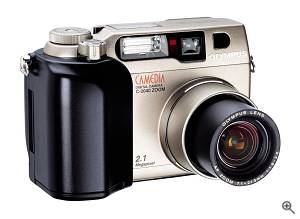 | | General |
|---|
| Model Number: | C-2040Z | | Camera Format: | Compact | | Retail Price: | $699 | | Date Available: | 2001-01-31 | | Image Capture |
|---|
| Image Sensor: | 0.5" 2.11 megapixel RGBG CCD | | Image Resolution: | 1600x1200, 1024x768, 640x480 | | Movie Resolution: | 320x240, 160x120 | | Lens |
|---|
| Focal Length (effective): | 40 - 120 mm (3.00x optical zoom) | | Digital Zoom: | Yes (2.5x, 5x in VGA mode) | | Auto Focus: | Yes (iESP TTL contrast detection) | | Manual Focus: | Yes | | Normal Focus Range: | 8 cm to Infinity
3.2 in to Infinity | | Macro Focus Range: | 8 - 20 cm
3.2 - 8.3 in | | Aperture Range: | f/1.8 - f/10 | | Display |
|---|
| Optical Viewfinder: | Yes (Real Image type) | | LCD Viewfinder: | Yes (1.8 inch, 114000 pixel) | | Exposure |
|---|
| ISO Settings: | 100 | | White Balance Settings: | daylight, overcast, tungsten light, fluorescent light | | Manual White Balance: | Yes | | Shutter Speeds: | 16 - 1/800 second | | Exp Adj Range: | +/- 2.0 EV in 0.33 EV steps | | Metering Modes: | iESP Multi, Spot | | Exposure Modes: | Aperture Priority, Shutter Priority, Manual | | Self Timer (seconds): | 12 | | Flash |
|---|
| Internal Flash: | Yes | | Flash Modes: | Auto, Red-Eye Reduction, Forced, Off, Slow 1&2, External | | Flash Range Description: | 3.1 inches to 18 feet (0.8 to 5.6 m) | | Ext Flash: | Yes | | Ext Flash Connection: | FL-40 external flash | | Image Storage |
|---|
| Flash Memory: | SmartMedia | | Memory Included (MB): | 8 | | File Formats: | TIFF, JPEG, QuickTime MotionJPEG | | More Information |
|---|
| Remote Control: | Yes | | Tripod Mount: | Yes | | Weight: | 307 g
10.7 oz | | Weight With Batteries? | No | | Size: | 110 x 76 x 70 mm
4.3 x 3.0 x 2.7 in | | Notes & Features: | Compatible with SmartMedia up to 64MB. Complies with DPOF and DCF. Lens has 10 elements in 7 groups. Exposures 4-16 seconds in manual mode only. Exposures 1/30 to 1/10000 second in movie mode. Bundled with camera strap, USB cable, video cable, lens cap, lens cap strap and quick-start guide. |
| Specification Highlights - full specifications here | | Olympus C-3040 Zoom |
|---|
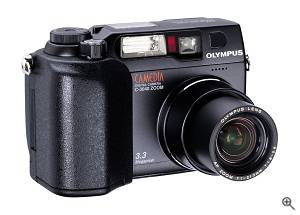 | | General |
|---|
| Model Number: | C-3040Z | | Camera Format: | Compact | | Retail Price: | $999 | | Date Available: | 2001-03-31 | | Image Capture | | Image Sensor: | 0.55" 3.34 megapixel RGBG CCD | | Image Resolution: | 2048x1536, 1600x1200, 1280x960, 1024x768, 640x480 | | Movie Resolution: | 320x240, 160x120 | | Lens | | Focal Length (effective): | 40 - 120 mm (3.00x optical zoom) | | Digital Zoom: | Yes (2.5x, 5x in VGA mode) | | Auto Focus: | Yes (iESP TTL contrast detection) | | Manual Focus: | Yes | | Normal Focus Range: | 8 cm to Infinity
3.2 in to Infinity | | Macro Focus Range: | 8 - 20 cm
3.2 - 8.3 in | | Aperture Range: | f/1.8 - f/10 | | Display | | Optical Viewfinder: | Yes (Real Image type) | | LCD Viewfinder: | Yes (1.8 inch, 114000 pixel) | | Exposure | | ISO Settings: | 100 (other settings unknown) | | White Balance Settings: | daylight, overcast, tungsten light, fluorescent light | | Manual White Balance: | Yes | | Shutter Speeds: | 16 - 1/800 second | | Exp Adj Range: | +/- 2.0 EV in 0.33 EV steps | | Metering Modes: | iESP Multi, Spot | | Exposure Modes: | Aperture Priority, Shutter Priority, Manual | | Self Timer (seconds): | 12 | | Flash | | Internal Flash: | Yes | | Flash Modes: | Auto, Red-Eye Reduction, Forced, Off, Slow 1&2, External | | Flash Range Description: | 3.1 inches to 18 feet (0.8 to 5.6 m) | | Ext Flash: | Yes | | Ext Flash Connection: | FL-40 external flash | | Image Storage | | Flash Memory: | SmartMedia | | Memory Included (MB): | 16 | | File Formats: | TIFF, JPEG, QuickTime MotionJPEG | | More Information | | Remote Control: | Yes | | Tripod Mount: | Yes | | Weight: | 307 g
10.7 oz | | Weight With Batteries? | No | | Size: | 110 x 76 x 70 mm
4.3 x 3.0 x 2.7 in | | Notes & Features: | Compatible with SmartMedia up to 64MB. Complies with DPOF and DCF. Lens has 10 elements in 7 groups. Exposures 4-16 seconds in manual mode only. Exposures 1/30 to 1/10000 second in movie mode. Bundled with camera case, remote control, camera strap, USB cable, video cable, lens cap, lens cap strap and quick-start guide. Very speedy 3.3 frames per second for 5 frames at highest resolution JPEG! |

Thursday, January 4, 2001
New features on PC Photo Review!
By Michael Tomkins, The Imaging Resource
(Thursday, January 4, 2001 - 20:30 EST)
 Our friends over at the PC Photo Review website have a new contest for readers running currently... The Holiday Photo Contest is seeking photos that "capture the spirit of the Holiday season" - and they needn't be from 2000, either. The contest runs through January 15th, and prizes include a copy of CompuPic Pro for the winner, and 1 year subscriptions to digitalFoto Magazine for two runners up... Our friends over at the PC Photo Review website have a new contest for readers running currently... The Holiday Photo Contest is seeking photos that "capture the spirit of the Holiday season" - and they needn't be from 2000, either. The contest runs through January 15th, and prizes include a copy of CompuPic Pro for the winner, and 1 year subscriptions to digitalFoto Magazine for two runners up...
The site has also added a new section entitled "Digital Photography Lessons". Three lessons have been posted thus far, "Starting out with your digital camera", "Basic Outdoor Portraiture", and "Simple Product Photography for the Internet". Check it out!

Imaging Resource Camera Finder/Database in public beta!
By Michael Tomkins, The Imaging Resource
(Thursday, January 4, 2001 - 15:45 EST)
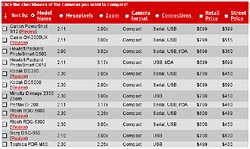
Wow! We're pretty excited about our new camera features database and the associated Camera Finder and Compare Cameras pages! The result of months of work, we're proud to unveil what we feel is the most comprehensive database of digicam features anywhere, including not only manufacturer data, but our own test results, such as minimum macro area, cycle time, shutter lag, and power consumption numbers (these latter are currently being entered, and will gradually appear over the next couple of weeks.) What's more, we're continually scanning the current US 'street' prices for all the current models, with the result that the entire database will have its street pricing updated at least every two weeks.
Best of all, you can search the database, to find which cameras meeting your needs for resolution, lens configuration, form factor, and computer connection fall into your price range. You can sort the results by any parameter, and you'll find links to our reviews of any cameras we've tested. Check it out!
Already know the cameras you're interested in? Visit the Compare Cameras page to see how they stack up feature by feature! (Again, including current list and street prices.)
We're calling this a 'public beta' of our digicam database, because we expect to be fleshing it out a little over the next week or two, and are hoping our intrepid readers will help us hammer on it a bit before we announce it to the world at large. It all works though, and overall is one of the biggest features we've added to our site to date!

Ofoto announces appointments!
By Michael Tomkins, The Imaging Resource
(Thursday, January 4, 2001 - 15:41 EST)
 Online photofinisher Ofoto, Inc. today announced that it has hired Denise Slattery as Chief Marketing Officer and Cameron C. Brown as Director of Corporate Communications, both newly created positions. Online photofinisher Ofoto, Inc. today announced that it has hired Denise Slattery as Chief Marketing Officer and Cameron C. Brown as Director of Corporate Communications, both newly created positions.
Slattery was most recently senior vice president of creative
development at San Francisco based apparel company, Joe Boxer Corp. A 14 year veteran and founding member of the Joe Boxer team, Slattery was responsible for creating and implementing all aspects of the company's positioning, marketing, advertising, business development, co-branding and product launch strategies. She also helped launch the company's first Web site in 1994 and spearheaded the creation of the company's e-commerce division, JoeBoxerDot. Her creative work earned a CLIO award in 1996. At Ofoto Slattery will oversee Ofoto's brand evolution and all strategic marketing programs, including online, off-line, product launches, partnership programs and customer acquisition strategies.
Brown was previously Director of Public and Investor Relations for SelfCare.com and brings more than two decades of communications experience to Ofoto. She has held senior communications positions at the Nasdaq Stock Market, ZDTV, Capital America and the Johns Hopkins University and spent the first decade of her career as a journalist for Cable News Network, the Associated Press, PBS and other media organizations. Brown has a degree in Communications and Journalism from the University of Arizona and lives in Oakland with her husband. At Ofoto Brown will oversee all internal and external communications programs."Ofoto is poised for explosive growth and brand recognition," said James Joaquin, CEO and president, Ofoto, Inc. "We clearly understand the importance of building a world-class brand through innovative marketing and strategic communications. Denise and Cameron are essential to that plan."

Qimage Pro 10.5 released!
By Michael Tomkins, The Imaging Resource
(Thursday, January 4, 2001 - 15:12 EST)
 Our good friend Mike Chaney just dropped us a note to let us know of a new version of his popular image viewing/printing/editing application, Qimage Pro. Mike released v10.4 a couple of days back, which fixed a couple of bugs and improved memory efficiency, and has already been superceded as follows: Our good friend Mike Chaney just dropped us a note to let us know of a new version of his popular image viewing/printing/editing application, Qimage Pro. Mike released v10.4 a couple of days back, which fixed a couple of bugs and improved memory efficiency, and has already been superceded as follows:"Qimage Pro v10.5 has a new feature that allows for reversal of vignetting and removal of uneven color casts using a gray test frame to equalize color distribution across the image. This new filter called "frame equalization" can not only remove vignetting caused by lenses but can also remove uneven color biases such as the slight green cast on the left side of Fuji S1 images (sample at the Qimage Pro site). Instructions on the use of this new filter are presented in the news at the Qimage Pro site.
In addition to this enhancement, several bug fixes and a further reduction of memory requirements have been implemented since the holidays. We also just finished building the ICC profile for the
Olympus C-3030Z camera, and on 12/29/00 updated the profiles for the D1, S1 and Nikon 990 making them more accurate than the older versions." Hop on over to the Qimage Pro website to grab the latest version and give it a try!
Source: Qimage Pro website

CORRECTED: Sound Vision, Motorola announce digicam reference design!
By Michael Tomkins, The Imaging Resource
(Thursday, January 4, 2001 - 13:21 EST)
 A new digital still camera reference design developed by Motorola Inc. and Sound Vision Inc. will, say the companies, allow camera manufacturers to deliver end-products more quickly. A new digital still camera reference design developed by Motorola Inc. and Sound Vision Inc. will, say the companies, allow camera manufacturers to deliver end-products more quickly.
The reference design, RoadRunner, is a complete hardware and software system solution, featuring components that the press release notes "enable a cost-effective, quick time-to-market solution for manufacturers of digital imaging products".
 The jointly developed design is targeted at manufacturers of low-cost digital-still cameras and other imaging applications, and features Motorola's recently announced MCM20027 megapixel SXGA CMOS image sensor and Sound Vision's Clarity 4 image processor. The jointly developed design is targeted at manufacturers of low-cost digital-still cameras and other imaging applications, and features Motorola's recently announced MCM20027 megapixel SXGA CMOS image sensor and Sound Vision's Clarity 4 image processor."We are excited at the prospects of a relationship with an image capture technology leader such as Motorola," said James F. Dunn, Sound Vision's vice president, Strategic Accounts.
"We're tremendously impressed with the first images from Motorola's new sensor and the underlying pinned photo diode technology. The image quality and signal-to-noise ratio is better than anything we've seen previously. We believe this reference design answers customers' needs and is the first step in taking them to the next level," said Dunn.
"We are very pleased to work with Sound Vision because they provide superior image processing technologies giving them a strong market leadership position," stated Larry Arbaugh, manager of Motorola's Image Capture Operations. "Their expertise, combined with ours, will help us to anticipate and deliver what the market needs." The RoadRunner reference design is scheduled to be available for evaluation in the first quarter of 2001.
Corrected 01-07-01 00:08: Thanks to Steve Hoffenberg at Sound Vision for correcting Mike's unintentional error (got to lay off that coffee!) - Sound Vision is not an HP spinoff, it is (in Steve's words) a "privately held company that was founded in 1995 by a group of engineers from the Leaf Systems division of Scitex, none of whom had any direct affiliation with Hewlett-Packard.". Apologies to Sound Vision for the error!
Source: Yahoo! Finance / Business Wire

Wednesday, January 3, 2001
Epson announces three new photo printers!
By Michael Tomkins, The Imaging Resource
(Wednesday, January 3, 2001 - 16:37 EST)
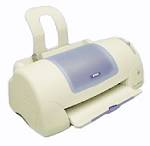 A news item from our friends over at digitalkamera.de in Germany notes that Epson has announced three new inkjet photo printers, the Stylus Photo 790, 890 and 1290. Our own search turned up announcements of the Stylus Photo 790 and 1290 on Epson Germany's website, as well as the Epson Stylus Photo 790 on the Epson Hong Kong website (apparently the 790 has been selling there for some time, having been announced on November 9th last year!) A news item from our friends over at digitalkamera.de in Germany notes that Epson has announced three new inkjet photo printers, the Stylus Photo 790, 890 and 1290. Our own search turned up announcements of the Stylus Photo 790 and 1290 on Epson Germany's website, as well as the Epson Stylus Photo 790 on the Epson Hong Kong website (apparently the 790 has been selling there for some time, having been announced on November 9th last year!)
At first glance, the new printers look to be an evolution of earlier models, featuring the same six ink colors (cyan, magenta, yellow, light-cyan, light-magenta and black) and 4-picoliter minimum droplet size as Epson's previous 1440 x 720 dpi 870, 875DC, 1270 and 2000P printers, coupled with the 2880 x 720 dpi hardware resolution of the later 777, 880, 980 and 980N printers. (The 777, 880, 980 and 980N were, however, four-color printers. Interestingly, the 980/980N printers offered a 3-picoliter droplet size even smaller than that on the newly announced printers!). The Stylus Photo 890 and 1290 get the paper roll-feed mechanism from the X7X printers, whilst the 790 similarly to the 777 and X8X printers cannot accept roll paper.
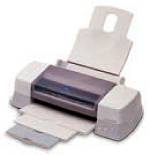 There are some differences, though! All three new printers get borderless (edge-to-edge) printing - but not just on roll paper, or on two edges. The new printers can print right to the edge of the paper on all sides! 'Natural Image Color' technology is claimed to "[extend] the visible color range that cannot be completely presented by colour monitors or digital cameras". The printer drivers for the new printers include a new 'edge smoothing function' which works along edges in diagrams and graphics to give a cleaner, less-pixelated line, along with an interpolation function for printing low-res images at larger sizes... There are some differences, though! All three new printers get borderless (edge-to-edge) printing - but not just on roll paper, or on two edges. The new printers can print right to the edge of the paper on all sides! 'Natural Image Color' technology is claimed to "[extend] the visible color range that cannot be completely presented by colour monitors or digital cameras". The printer drivers for the new printers include a new 'edge smoothing function' which works along edges in diagrams and graphics to give a cleaner, less-pixelated line, along with an interpolation function for printing low-res images at larger sizes...
The Stylus Photo 790 and 890 can handle paper up to the European 'A4' format, whilst the 1290 accepts paper up to the larger 'A3' format. All three printers feature PC/Mac compatible USB and parallel connectivity. Print speeds for the Stylus Photo 790 are 7.8 ppm (pages per minute) in black text in economy mode on A4 paper, and 7.5ppm for color text in economy mode. In photo-quality mode, the 790 takes 209 seconds to print an A4 photo, which Epson claims is 80% faster than other inkjet printers in the same class. Print speeds for the Stylus Photo 1290 are 9.4ppm economy black text, 9ppm economy color text, and 220 seconds for an A4 color photo. Print speeds for the Stylus Photo 890 are not yet available. The Stylus Photo 790 is somewhat noisier at 47dB(A) than the 890 and 1290, both of which are rated at 42dB(A). By comparison, the Stylus Color 777 is rated at 47dB(A), and the 870, 875DC, 1270 and 2000P printers are rated at 38dB(A)...
According to digitalkamera.de, the printers will ship in Europe this month at a cost of EUR200 (US$190) for the Stylus Photo 790, EUR250 (US$237) for the Stylus Photo 890, and EUR500 (US$380) for the Stylus Photo 1290. The Stylus Photo 790 currently sells at an MSRP of HK$1,588 (US$204) in Hong Kong, and is listed at DM399 (US$193) in Germany, whilst the Stylus Photo 1290 is listed at DM999 (US$485) in Germany.
Source: DigitalKamera.de website
Thanks to digitalkamera.de for this item!

Sharp announces color fax/photo printer combo!
By Michael Tomkins, The Imaging Resource
(Wednesday, January 3, 2001 - 10:50 EST)
 Sharp Corp. plans to launch a combination color fax machine and photo printer in Japan on Jan 19, 2001, according to an article on Nikkei BP Network's AsiaBizTech website. The Sharp 'Fappy' UX-E3CL fax machine includes a 600dpi three-color CMY ink-jet printer with built-in PC card reader (compatible with CompactFlash, SmartMedia, MemoryStick, MultiMediaCard and SD card with appropriate adapters), and a 10 x 30 character monochrome LCD display for control and image preview. The unit also includes phone and fax functionality, including the ability to fax images from digital cameras, and to attach images to emails using Sharp's 'Space Town' service. The printer/fax combo is able to read JPEG images only, and should retail for around ¥70,000 (US$611), with 10,000 units expected to be sold. See Nikkei BP's news item for a photo of the 'Fappy' (where do they come up with these names? ;) Sharp Corp. plans to launch a combination color fax machine and photo printer in Japan on Jan 19, 2001, according to an article on Nikkei BP Network's AsiaBizTech website. The Sharp 'Fappy' UX-E3CL fax machine includes a 600dpi three-color CMY ink-jet printer with built-in PC card reader (compatible with CompactFlash, SmartMedia, MemoryStick, MultiMediaCard and SD card with appropriate adapters), and a 10 x 30 character monochrome LCD display for control and image preview. The unit also includes phone and fax functionality, including the ability to fax images from digital cameras, and to attach images to emails using Sharp's 'Space Town' service. The printer/fax combo is able to read JPEG images only, and should retail for around ¥70,000 (US$611), with 10,000 units expected to be sold. See Nikkei BP's news item for a photo of the 'Fappy' (where do they come up with these names? ;)
Source: Nikkei BP Network's AsiaBizTech website

Tuesday, January 2, 2001
Motorola announces 1.3 megapixel CMOS sensor!
By Michael Tomkins, The Imaging Resource
(Tuesday, January 2, 2001 - 18:45 EST)
 Motorola Inc. has today announced a new 1.3 megapixel CMOS image sensor aimed at manufacturers of imaging products such as digital still cameras, video systems and other imaging applications. Motorola Inc. has today announced a new 1.3 megapixel CMOS image sensor aimed at manufacturers of imaging products such as digital still cameras, video systems and other imaging applications.
As the low-cost digital imaging market expands from VGA (640 x 480 pixel resolution) to SXGA (1280 x 1024 pixel resolution) products, Motorola feels that its introduction of the MCM20027 SXGA image sensor "brings a new cost-effective option to manufacturers of these megapixel imaging applications". Implemented using Motorola's ImageMOS process, the MCM20027 features both analog and digital signal processing in a 'camera-on-a-chip' design.
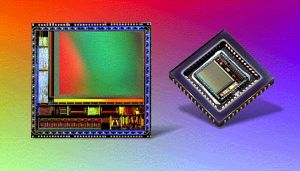
Targeted at cost-sensitive digital still cameras, video systems and other imaging applications, the MCM20027 is manufactured with a wafer process using a patented pinned photo diode and pixel design technology from Motorola and Kodak. Motorola says its new image sensor "features a unique pixel design, which provides improved fill factor versus die size. The quantum efficiency of the image sensor minimizes noise while maintaining excellent light sensitivity across the visible spectrum"."The MCM20027 strengthens Motorola's position as a leading supplier of CMOS image sensors, and expands the company's CMOS image sensor portfolio from several custom and standard products to include a high-quality 1.3 megapixel SXGA image sensor," stated Larry Arbaugh, manager of Motorola's Image Capture Operations. "This will enable camera manufacturers to develop higher-quality consumer products at affordable prices." The MCM20027 is designed as a 1280 x 1024 pixel progressive scan image sensor with integrated correlated double sampling, programmable gain amplifier and analog-to-digital converter. The 6 um by 6 um pixel pitch provides light sensitivity to 3 LUX at 10 frames per second. The MCM20027 incorporates an integrated Bayer RGB color filter array and microlenses for maximum sensitivity. The sensor outputs 10-bit Bayer encoded RGB data with all appropriate frame-timing signals.
The MCM20027 requires less than 250 mW of power and has a power-savings mode of 100 uW for improved performance in power-sensitive battery applications. The sensor architecture supports programmable 'window-of-interest' for pan-and-scan, digital zoom and other sub-sampling modes.
Motorola plans to begin offering samples of the MCM20027 image sensor in January 2001. The suggested resale price of the MCM20027 is $22 in 10,000-piece quantities, dependent upon the quantity ordered. Kodak also plans to offer the sensors under its own brand name as the KAC-1310, as described in our September 11, 2000 news item, "Motorola, Kodak cooperate on CMOS sensors!".
Source: Yahoo! Finance / BusinessWire

Web Droid - Lost and Found! ;)
By Michael Tomkins, The Imaging Resource
(Tuesday, January 2, 2001 - 17:41 EST)
It has been an extremely chaotic day for Mike today... A change of local cable company means a change of Internet provider - but the new installation has not gone smoothly, to say the least! Add to the hours that I've spent on the phone trying to get things working the fact that my backup, a dial-up internet account, had mysteriously vanished from my computer, and it seems the gods have conspired to keep me offline today! Never fear though - we've a few news items to come today, and now I'm back online (albeit at a 48Kbps crawl) I'll be getting to posting them later this evening... Apparently, technology is no more reliable at the start of the new millennium than it was at the end of the old one. ;) Happy New Year!


AOL Alert: Several readers connecting
via AOL have complained of poor image quality when using the AOL web browser.
This is caused by a setting called "compress images" in the browser
that causes it to completely mangle images in the interest of faster transmission.
You should turn this setting OFF before viewing any of the comparison images
on this site.
- FLASH: Thanks to reader Lynn Mannan, here's an explanation of how to
make the correct settings adjustments (at least in AOL 4.0 for PCs):

- I opened the "My AOL" preferences screen
in the toolbar across the top. Then I clicked on WWW icon and selected
the "web graphics" tab where I unchecked the "compressed
graphics" choice and clicked on the Apply button at the bottom. Now
the scanner test pictures are gorgeous. The pictures take a long time to
load. But they are worth waiting for. Thank
you, Lynn!
|
 |
|